Ask the same question in 11 AI search engines, and you’ll get 11 different answers.
Sometimes wildly different.
Some engines focus on visuals and shoppable results. Others go deep into research. A few just try to get you an answer, fast.
Each platform prioritizes and presents it differently.
And those differences matter.
Not just for users, but for brands trying to get discovered in AI search.
So, I tested popular and lesser-known AI engines on accuracy, depth, user experience, and other factors.
Only four made the cut.
In this guide, you’ll learn which AI search engines came out on top, including pros, cons, and pricing. I’ll also share which engines didn’t make my list, and why.
Along the way, you’ll get a few tips on using these insights to improve your AI visibility.
Start with a quick overview of my findings below. Or jump straight to the #1 AI search engine on my list: ChatGPT.
What Are the Best AI Search Engines?
| Tool | Best for | Pros | Cons | Price |
|---|---|---|---|---|
| ChatGPT | Comprehensive research and shoppable product comparisons | Visual layout with tables and images; remembers context across follow-ups; direct purchase links | Overwhelming results for broad queries; accuracy issues; overly agreeable | Free or $20+/month |
| Google AI Mode | Quick product searches with real buyer reviews | Fast product results with pricing and reviews; integrates Google ecosystem | Vague on informational queries; no comparison tables; unavailable in some regions | Free |
| Sigma Chat (Formerly Bagoodex) | Research deep dives that build on previous questions | Strong conversational memory; suggests follow-up questions; content creation prompts | Weak product presentation; no pricing or buy links; poor visuals | Free or $10+/month |
| Microsoft Copilot | Fast answers in clean, skimmable formats | Clean categorization; fast responses; easy to skim | Surface-level depth; no product links; weak for shopping | Free |
How I Tested 11 AI Search Engines
To keep things consistent, I ran the same set of prompts across 11 AI search tools.
Note: For this article, I defined “AI search engine” as any generative AI platform that can understand queries, pull information from sources, and deliver answers in natural language.
This included big names like ChatGPT, AI Mode, and Perplexity.
And newer players like Arc, Andi, and Sigma Chat.
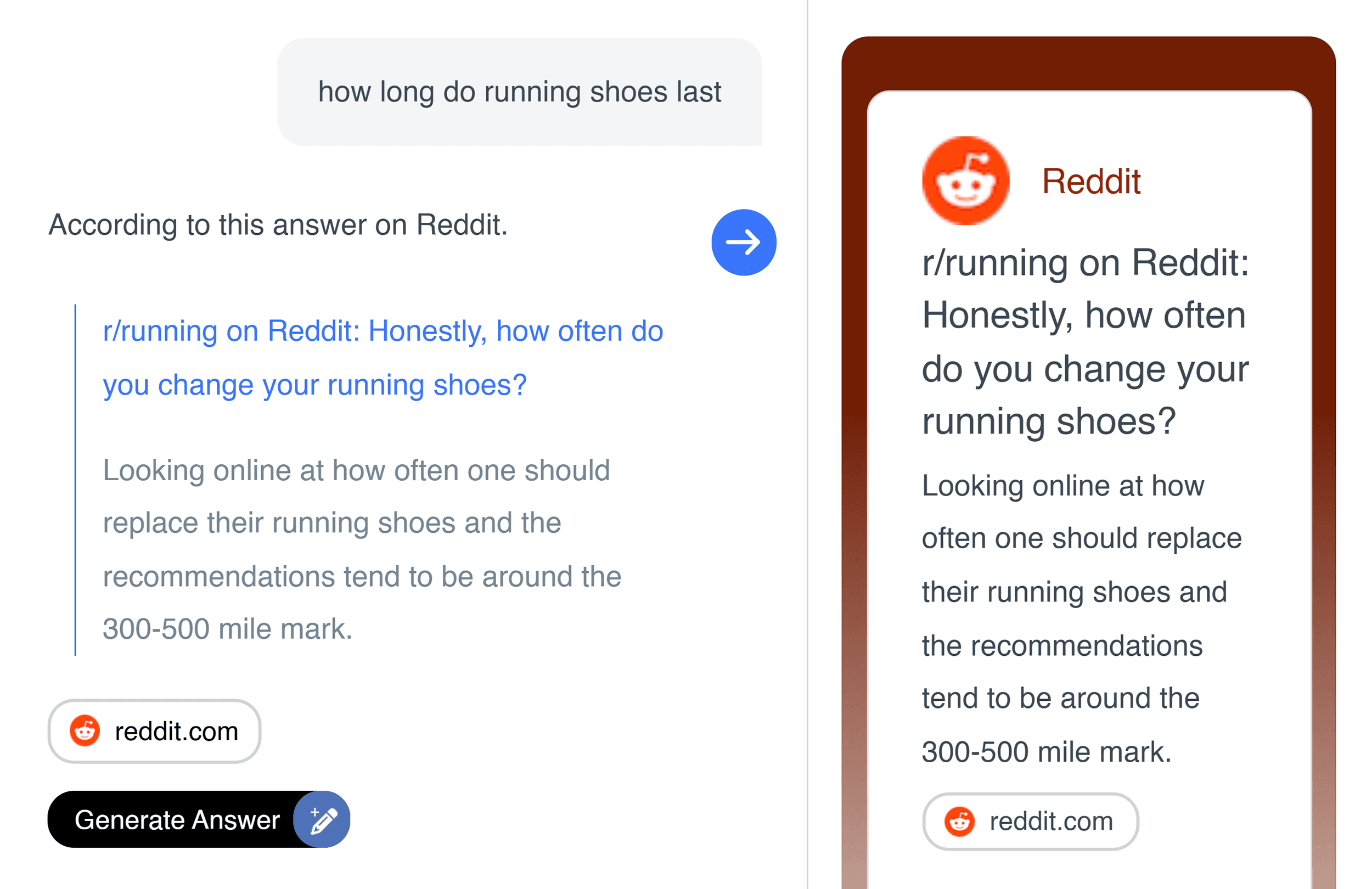
I focused on one topic (running shoes) and tested a range of prompts across different search intents.
This showed how well each engine handled the full customer journey, from research to shopping.
This included:
- “Best running shoes”: Assesses top-level recommendations and how each engine handles broad prompts
- “Best running shoes for beginner marathon training”: Evaluates personalization and context handling as the prompt narrows
- “How long do running shoes last?”: Gauges accuracy on general product knowledge and durability expectations
- “Of the trainers you’ve recommended, which ones will last the longest?”: Tests the accuracy of product details and the engine’s ability to remember details from previous prompts
- “Can I wear any of these running shoes recommended for hiking?”: Assesses how each AI handles reasoning, real-world nuance, and potential safety considerations
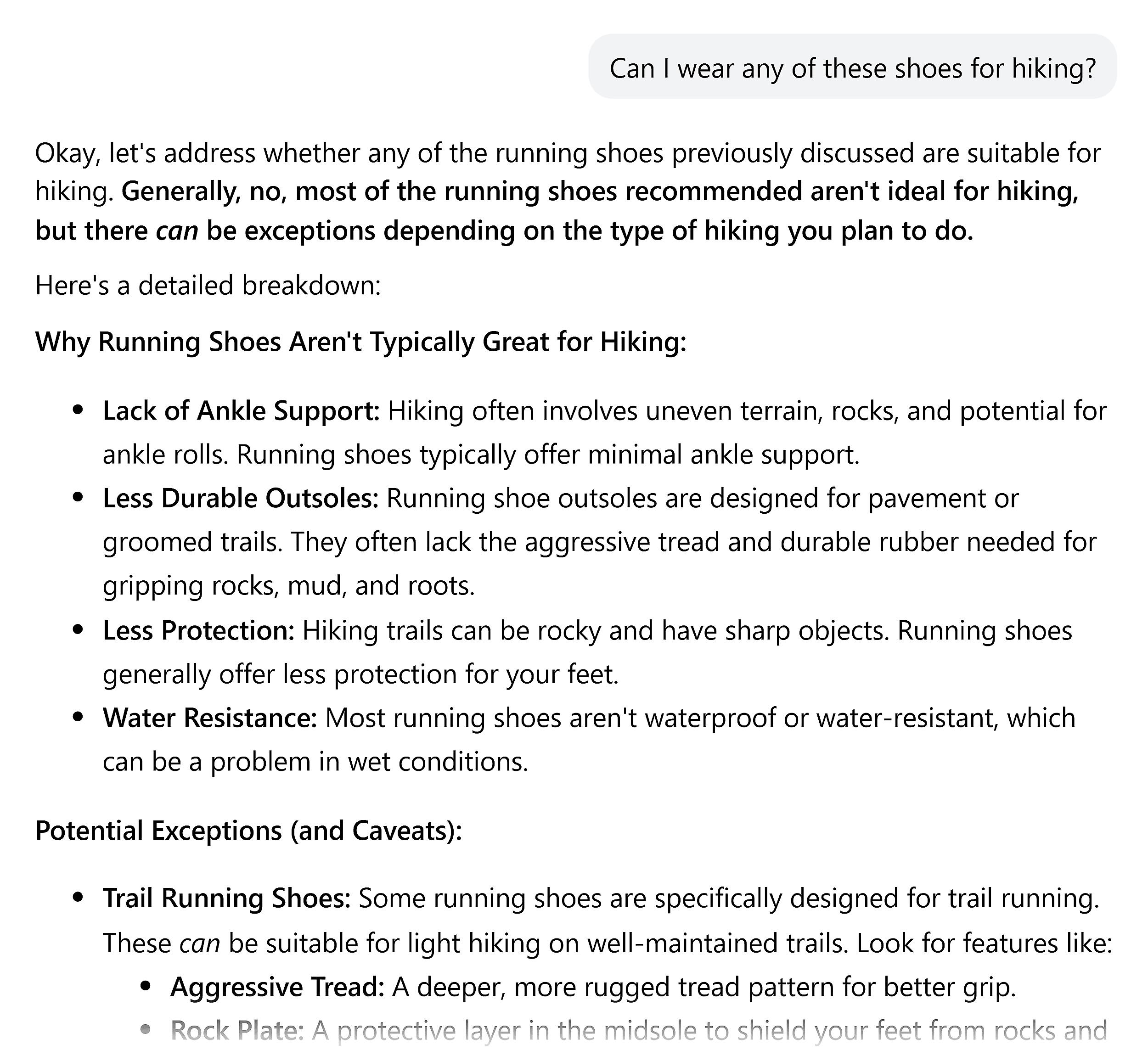
I evaluated each tool on five factors:
- Accuracy: Did it understand the intent and get the facts right?
- Depth: Did it add helpful context or just summarize existing content?
- Transparency: Did it credit or link to its sources?
- User experience: Was the output fast, skimmable, and well-organized?
- Adaptability: Could it handle follow-up questions naturally or refine vague prompts?
After testing all 11 AI search engines, these four stood out as the best for different reasons.
1. ChatGPT
Best for comprehensive research and shoppable product comparisons
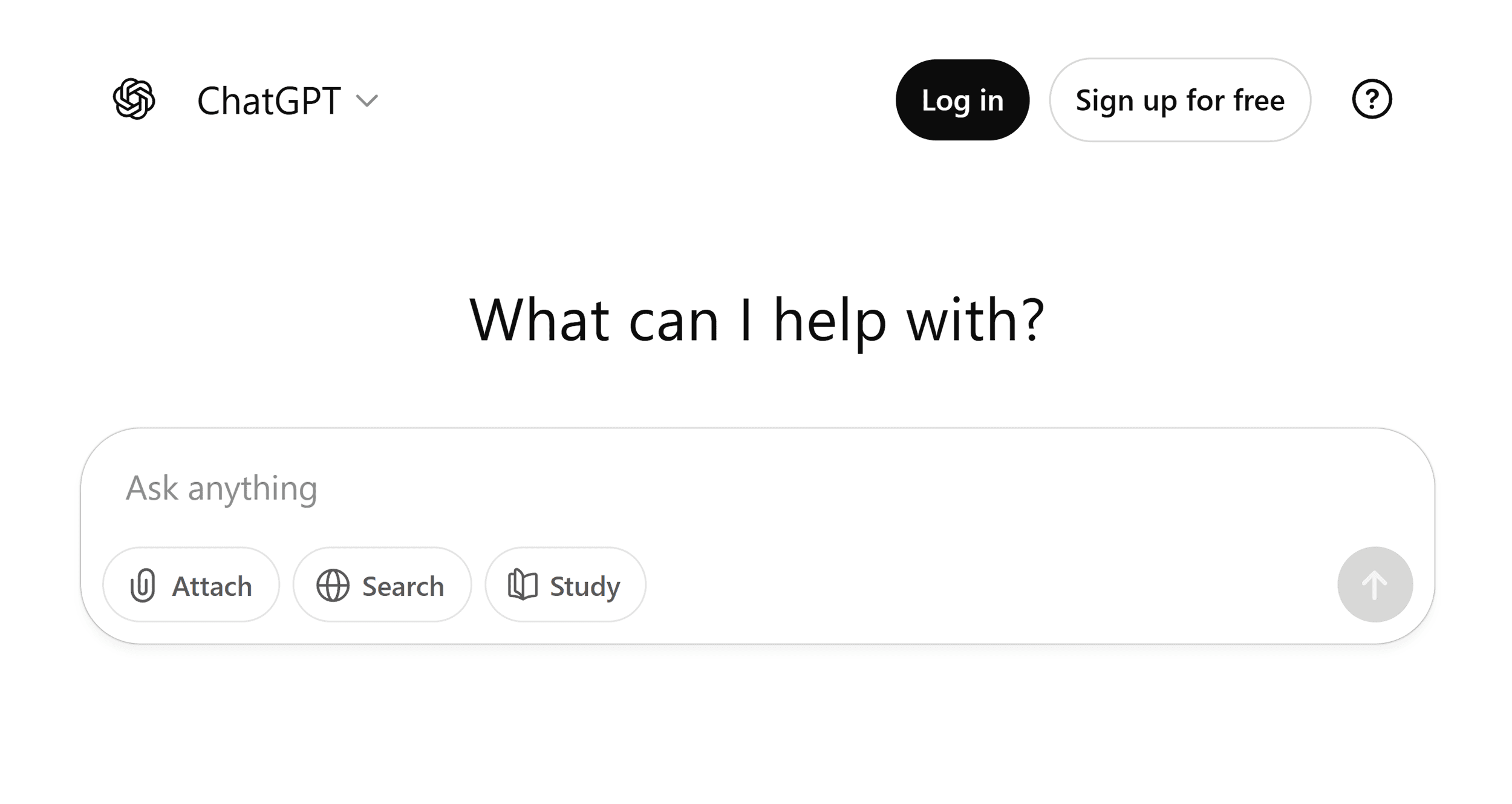
ChatGPT came out on top overall.
It delivered the best balance of accuracy, organization, and depth. Plus, it showed an “understanding” of search intent and included helpful visuals.
What ChatGPT Does Well
ChatGPT provides detailed, well-formatted answers.
This is true whether you’re comparing products, researching topics, or looking for a step-by-step tutorial.
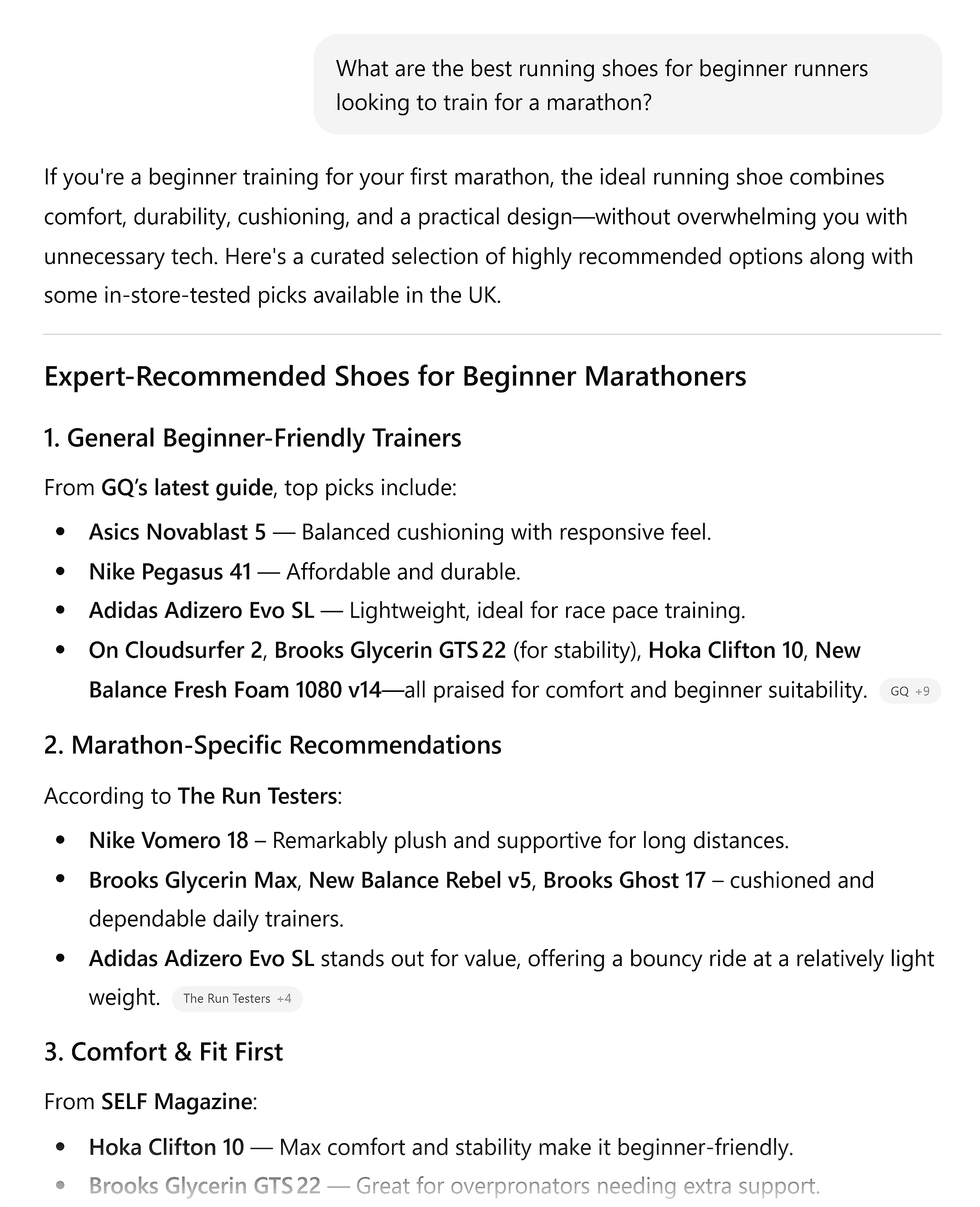
It also remembers context across follow-up questions.
I started with a broad prompt and added specifics as the conversation progressed. ChatGPT remembered key details without making me repeat myself.
For shopping queries, the visual presentation stood out.
When I searched for running shoes, for example, ChatGPT returned products with images, prices, reviews, and short descriptions.
It also included links to retailers and external articles. This made verifying product details and purchasing easy.
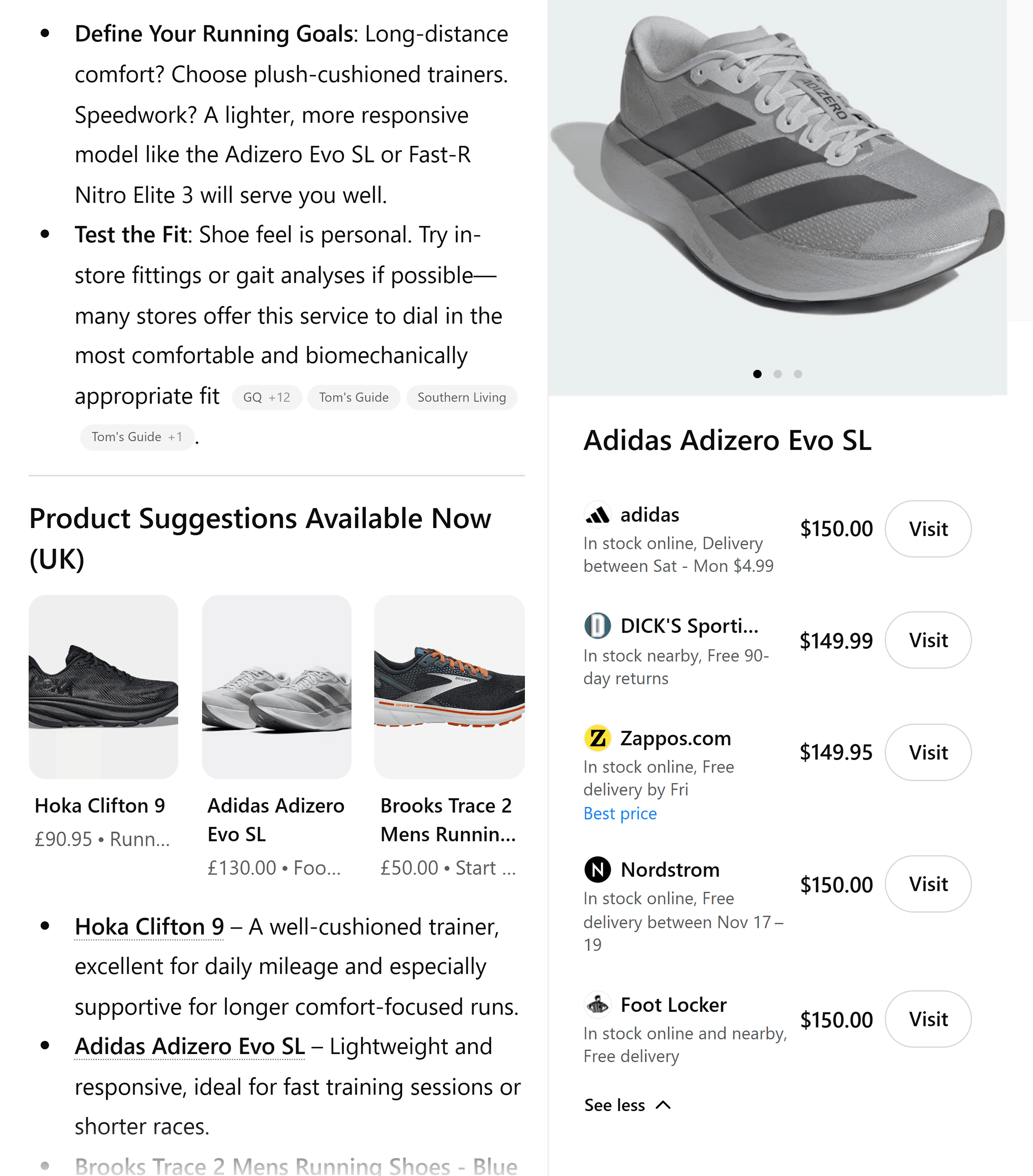
The summary tables were particularly useful.
After inquiring about shoe lifespan, ChatGPT delivered a clean comparison table with products and their expected mileage.
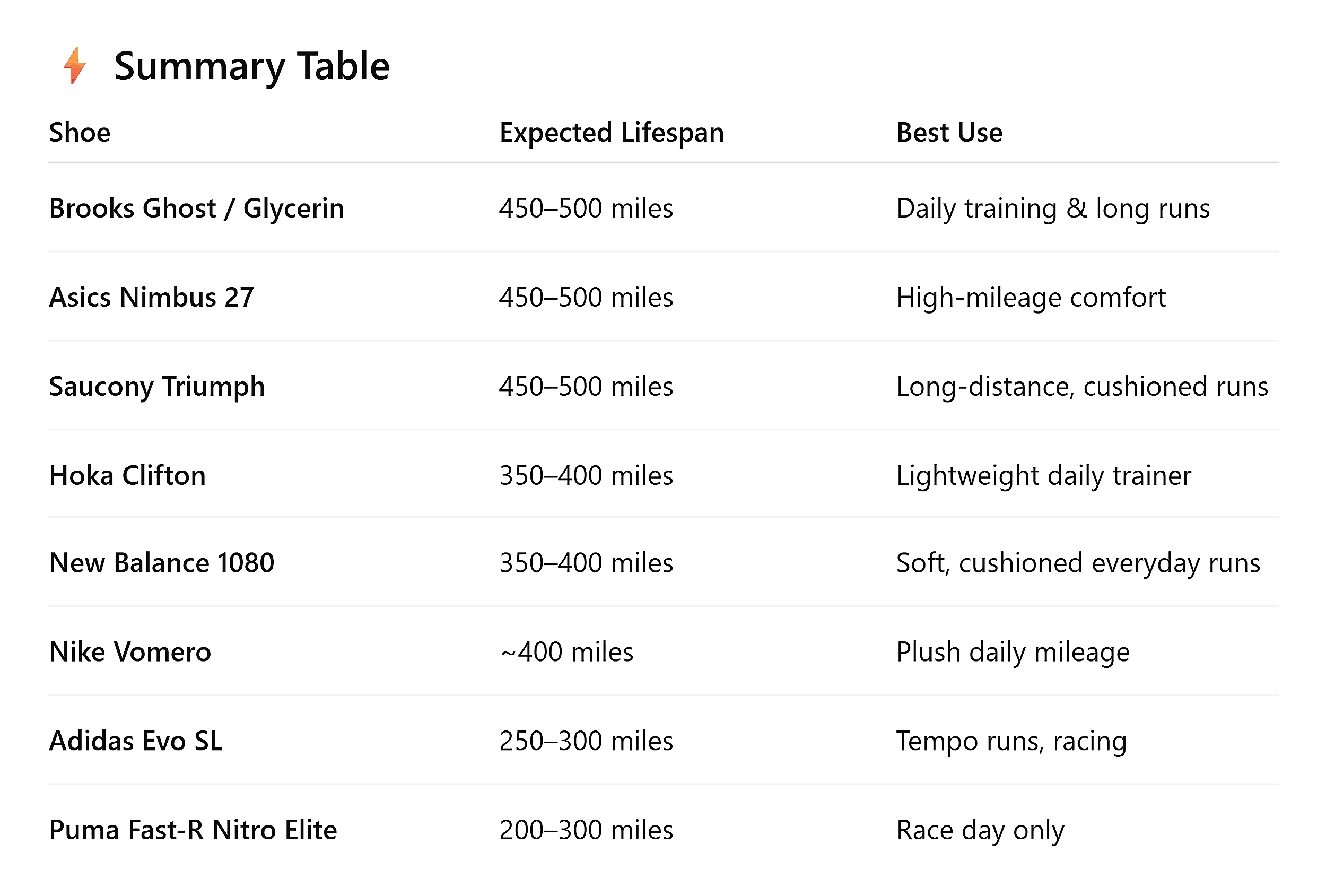
For brands: ChatGPT’s visual layout isn’t just useful for shoppers. If you’re trying to get your brand referenced by AI search engines, it also reveals what these models prioritize. Use tables, clear specs, and organized categories on your product pages to help both shoppers and AI find your information faster.
ChatGPT is also evolving quickly.
Features like Instant Checkout (currently limited to select Etsy sellers in the United States) let users complete purchases directly inside the chat.

Great for shoppers — and even greater for the brands featured in ChatGPT’s recommendations.
Where ChatGPT Falls Short
When I tested ChatGPT, I got what most people want from AI search: answers that feel confident and complete.
But not every response was perfect.
Broad prompts, such as “Best running shoes,” resulted in lengthy lists of brands, product categories, and features.
The information took real effort to digest.
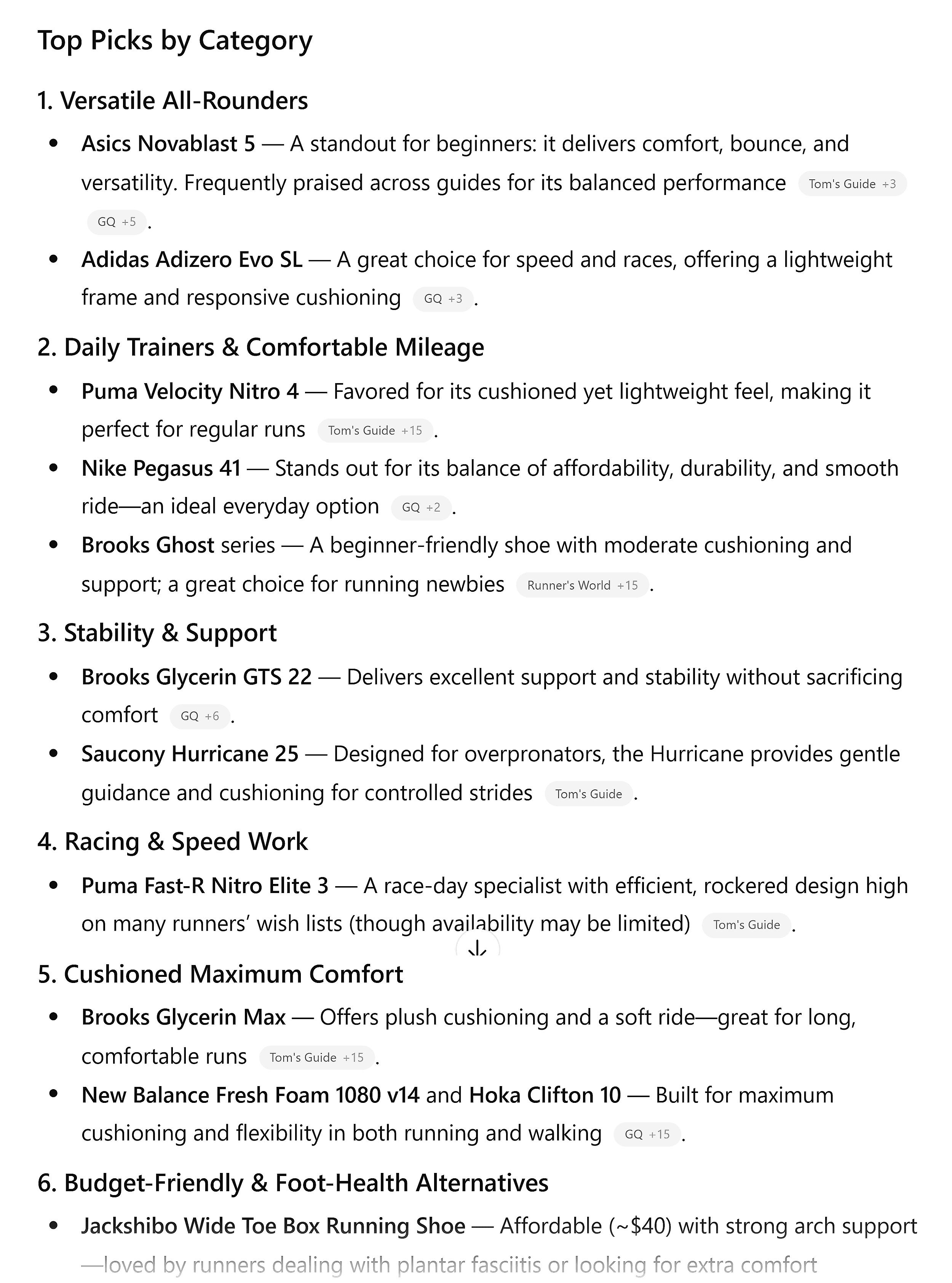
Specific prompts worked much better.
I also noticed minor inaccuracies in some instances, like when I asked about shoe lifespan.
After fact-checking the replies, some details didn’t match the manufacturer’s specifications.
For example, ChatGPT said the Brooks Ghost running shoe has a lifespan of 450 to 500 miles. But the actual range is 300 to 500 miles.
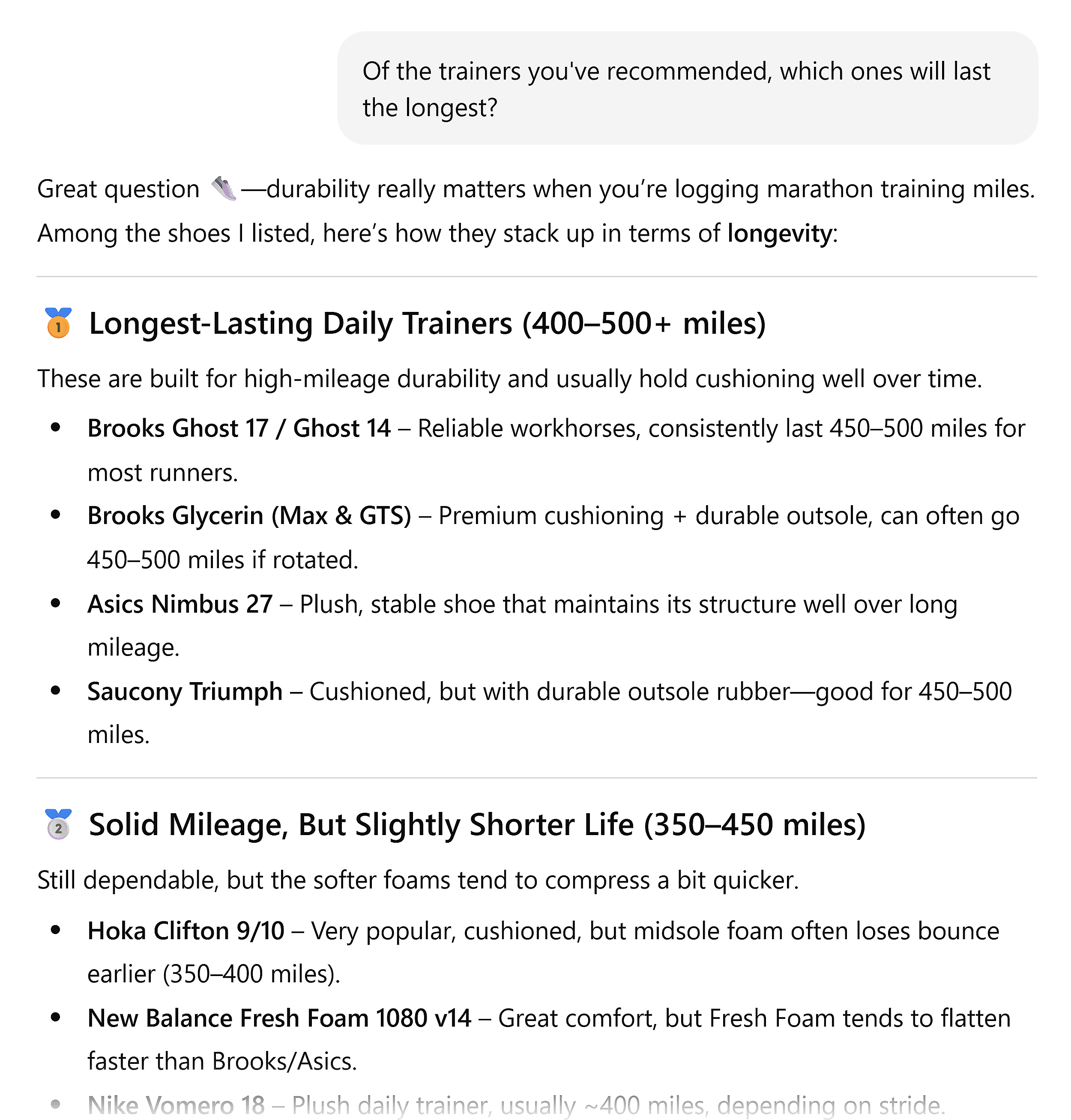
This also highlights a larger problem.
ChatGPT pulls information from multiple sources, such as blog posts and brand sites.
But it also relies on forums like Quora and Reddit, where users share personal experiences.

It then aggregates the information into its responses. This can lead to inaccurate and misleading information.
For brands: Provide clear answers to common user questions on your site. Otherwise, AI search engines may turn to other, potentially inaccurate sources for this information. Add tables with specifications, be explicit about ranges and measurements, and use structured data so AI can extract and cite your product information correctly.
ChatGPT also tends to be overly agreeable.
Whatever you prompt, ChatGPT will lean toward flattery and agreement — even when it involves safety.
For example, when I asked, “Can I wear any of these running shoes recommended for hiking?”
ChatGPT’s response was:
“Good question 👍 — you can hike in road running shoes, but whether it’s a good idea depends on the terrain and how far you’re going.”
Not the worst.
But not as good as other AI search engines in this aspect, like AI Mode, which was more cautious.
AI Mode said:
“It is not recommended to use the road running shoes previously mentioned for hiking…they lack the key features that provide the necessary grip, protection, and stability for off-road trails. Using them for hiking could lead to injury.”
Overall, ChatGPT is fast, detailed, and helpful.
But it can be too generous with information — and too polite to push back.
Pricing
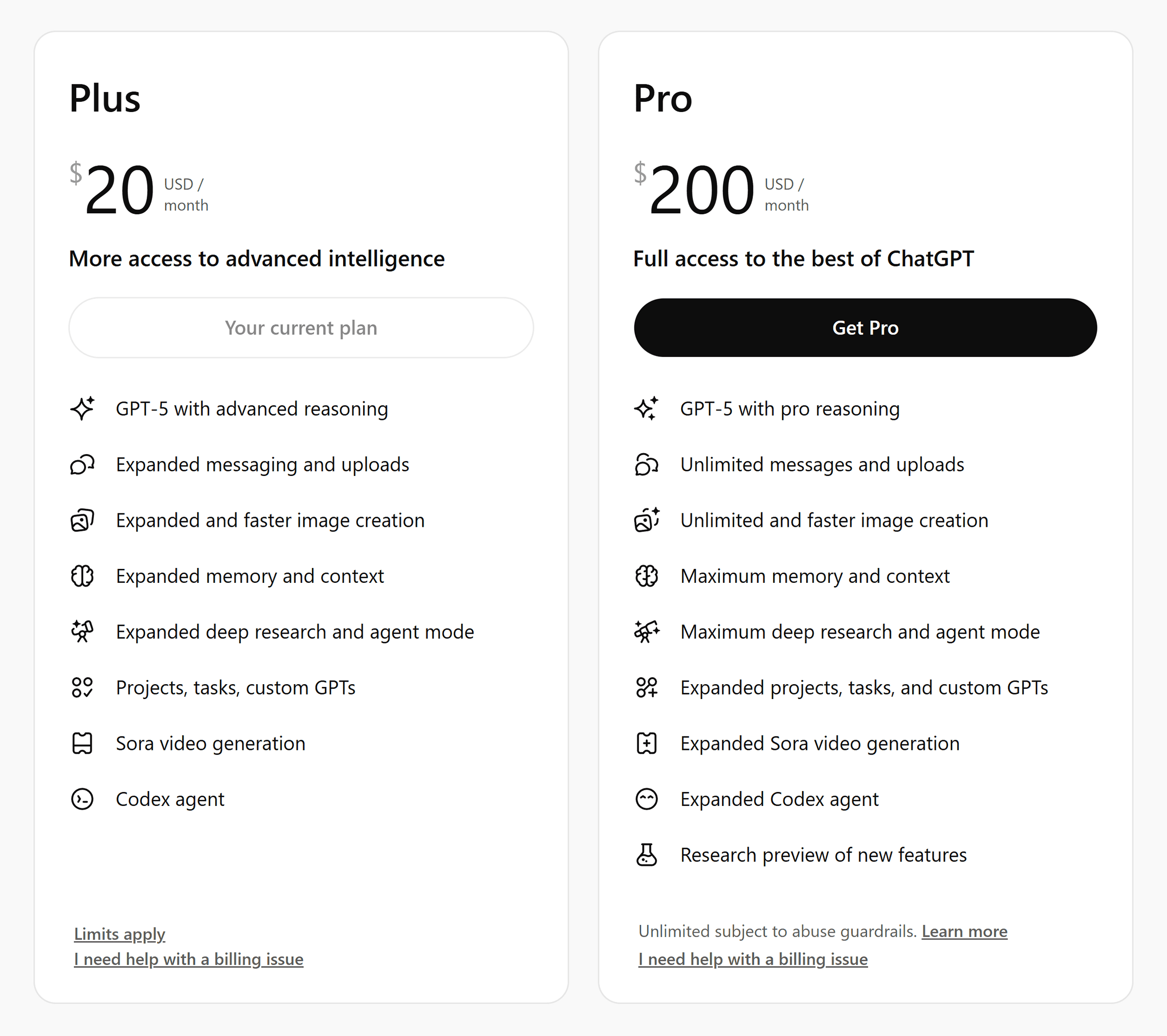
ChatGPT offers three plans based on your needs.
- Free: Limited access to some features
- Plus: $20/month
- Pro: $200/month for extended features
Further reading: Google Gemini vs. ChatGPT: Which AI Chatbot Is Better?
2. Google AI Mode
Best for quick product searches with real buyer reviews
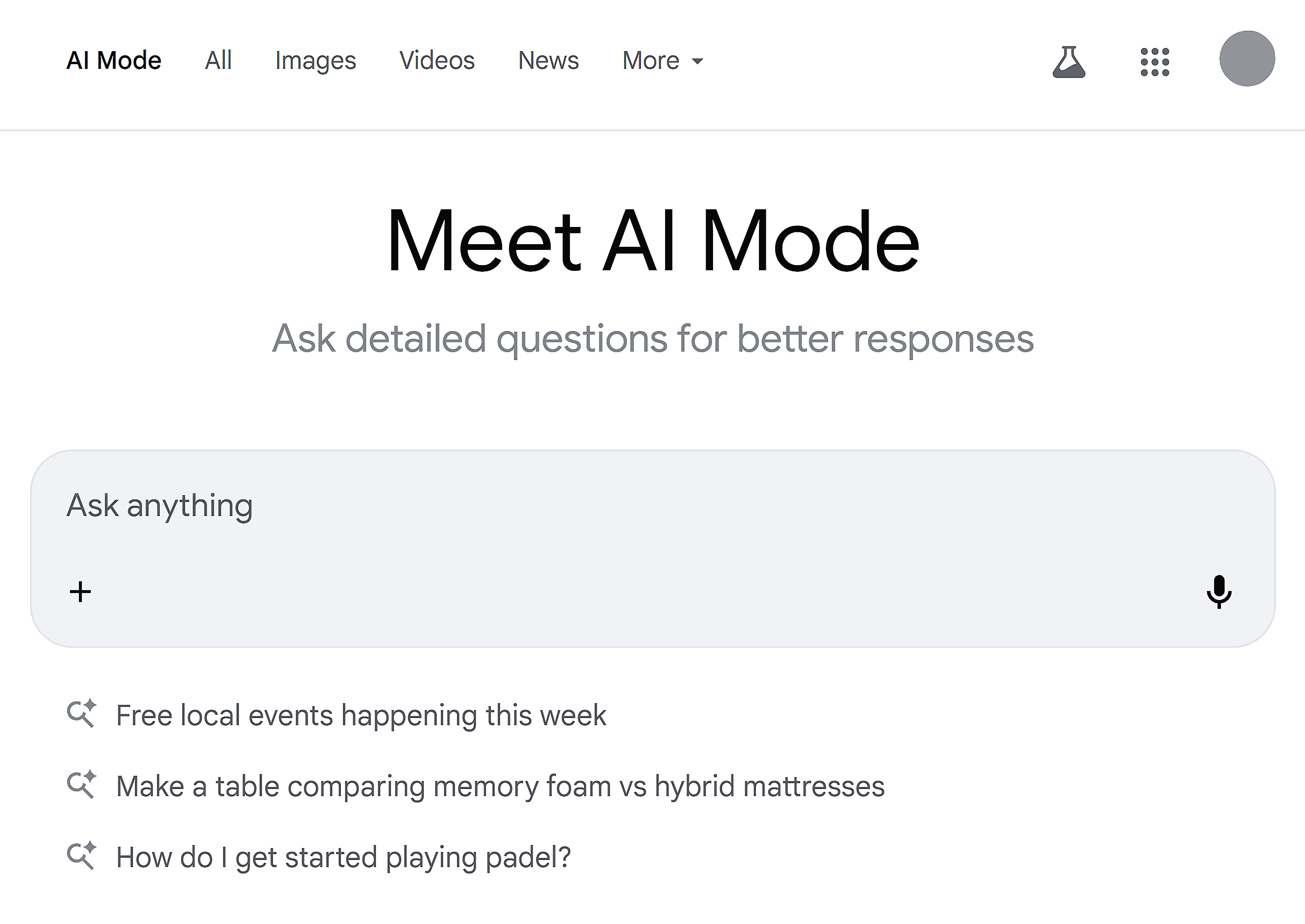
Google’s AI Mode is built for speed.
It pulls product listings, prices, and reviews directly into the search interface. This makes it ideal for shoppers who want to quickly compare products before purchasing.
What AI Mode Does Well
AI Mode shines when you have clear buying intent.
It instantly surfaces product options with images, prices, star ratings, and quick links to retailers. And it’s all in a clean, scrollable layout.
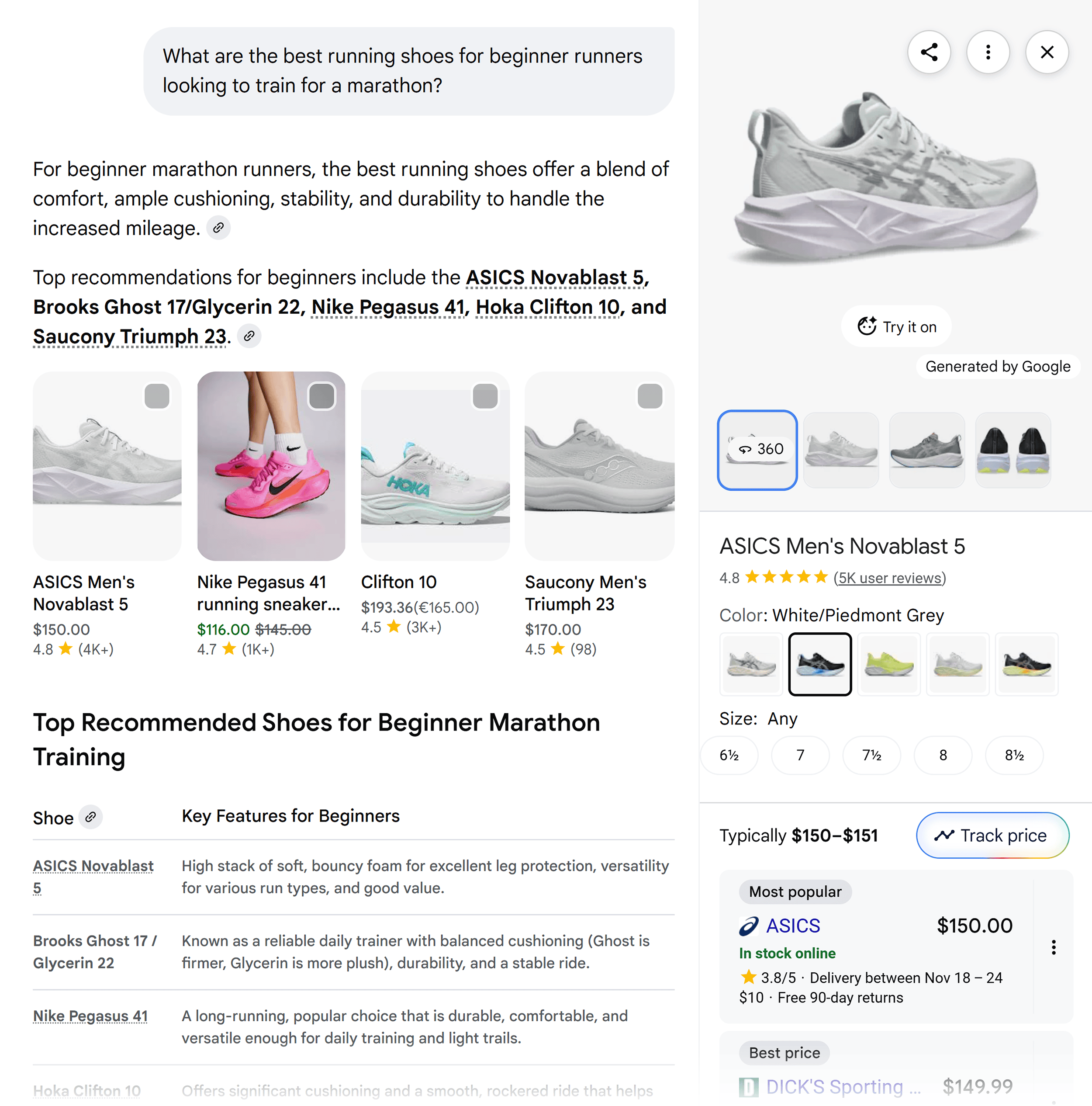
When I searched “best running shoes,” it showed a curated carousel of options with price comparisons across multiple sites.
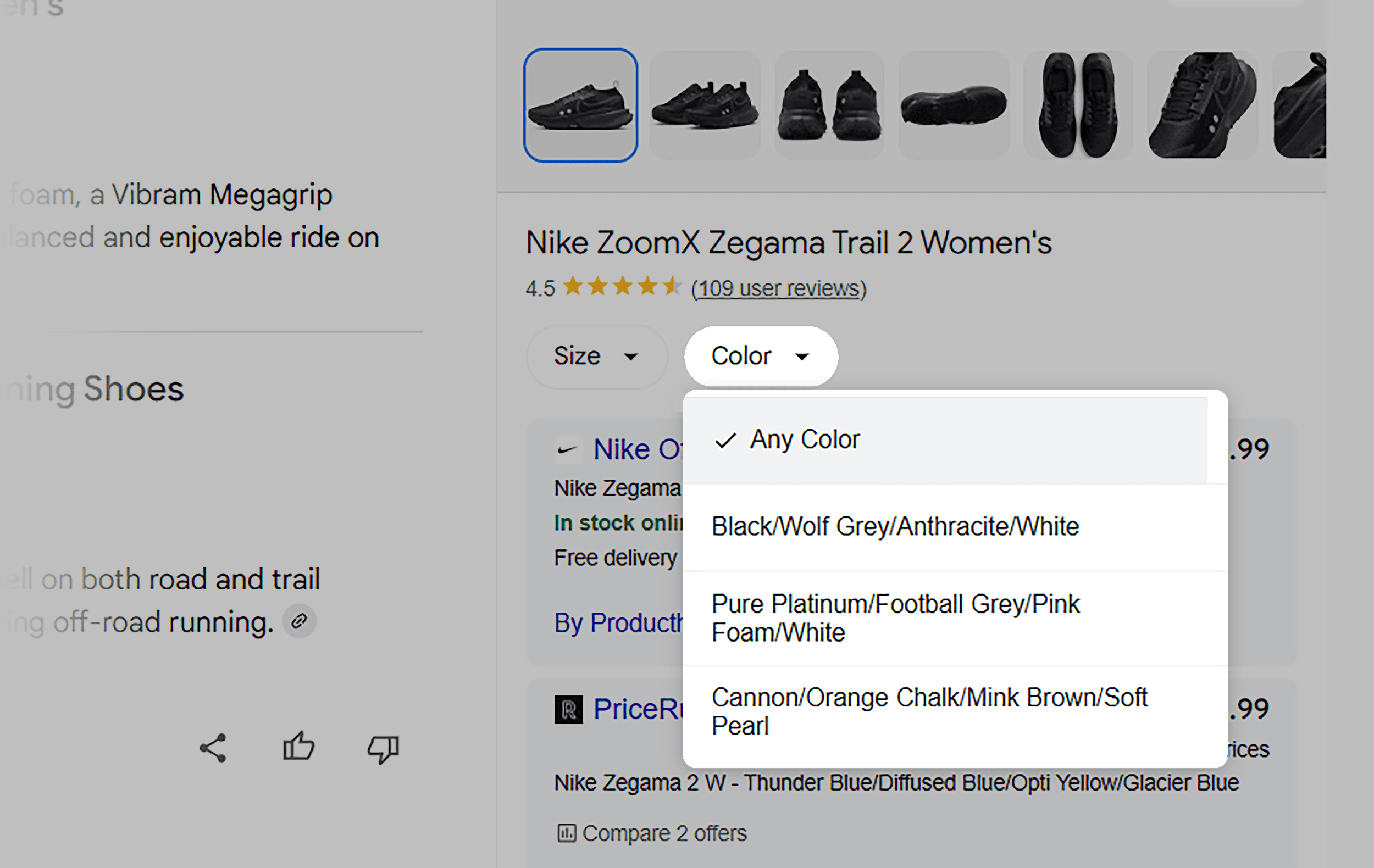
I especially liked how it paired Google Reviews with its recommendations — a small detail that makes decision-making faster and builds trust.

For me, that worked perfectly.
Getting straight to the products moved me faster toward a decision.
But some users may prefer more background or context for researching and weighing options. ChatGPT’s research-style answers still win in this regard.
For brands: AI Mode pulls heavily from Google Reviews and structured product data. Focus on getting detailed, positive reviews and keeping your product schema markup up to date. These signals can influence whether your products appear in AI-generated results.
Where AI Mode Falls Short
AI Mode is not yet available in all countries, although it’s rolling out quickly.
And unlike ChatGPT, it didn’t provide any comparison tables for any of my prompts. Just products and bullet points.
This meant more scrolling and clicking to find and digest the information.

This was evident when I asked which of the recommended shoes would last the longest.
AI Mode’s response was vague and unhelpful. It said the Brooks Ghost shoe was “exceptionally long-lasting.”
It didn’t provide any of the specifics that would make me want to purchase this shoe. Like mileage range and how it differed between the options.

If you’re early in the evaluation phase, AI Mode can feel limiting.
But it delivers when you want a shortlist of top contenders.
Pricing
AI Mode is available for free within Google Search, depending on your region.
Further reading: LLM Seeding: A Strategy to Get Mentioned and Cited by LLMs
3. Sigma Chat (Formerly Bagoodex)
Best for research deep dives that build on previous questions
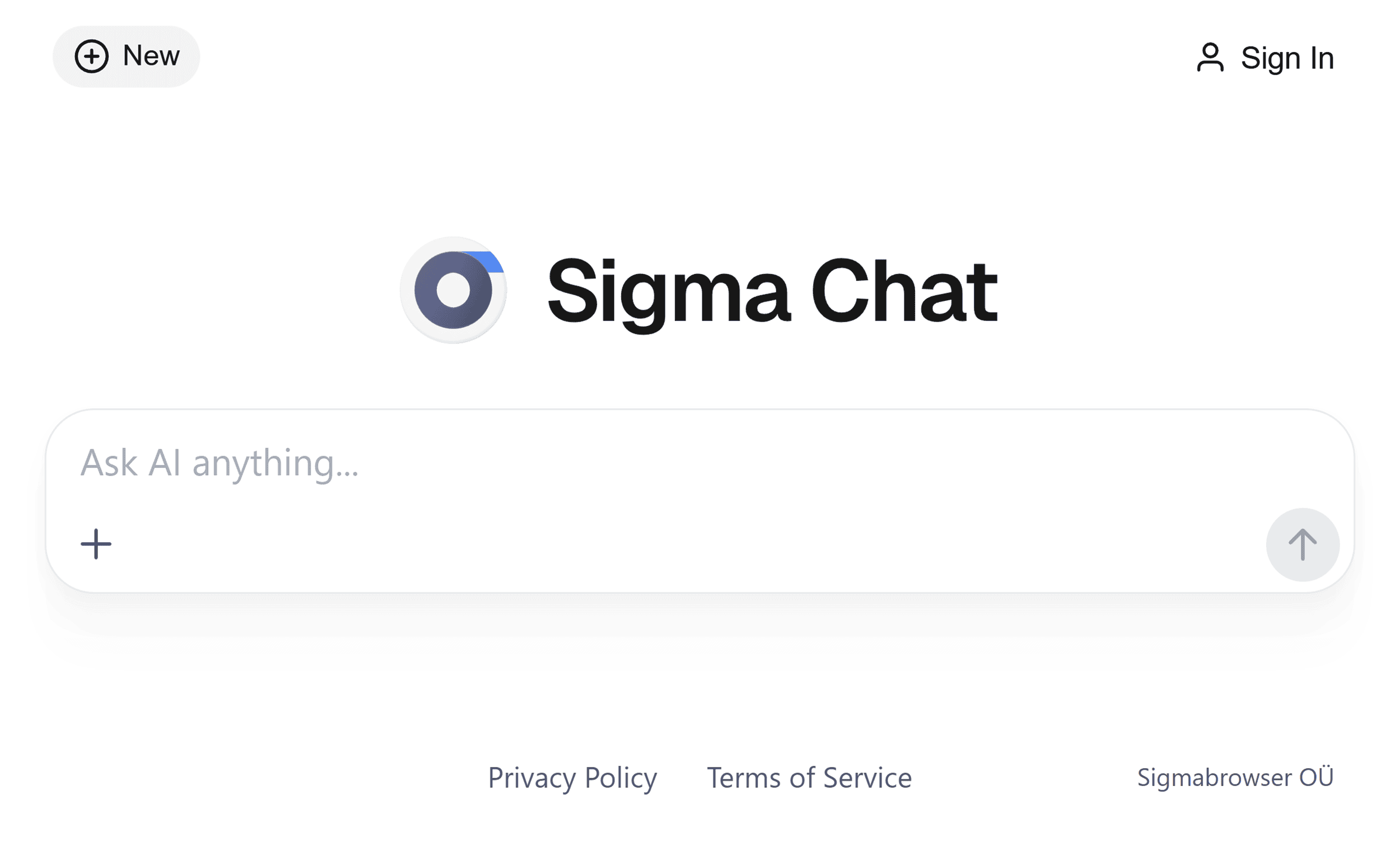
Sigma Chat’s iterative search and in-depth replies are excellent if you love to research.
Ask a question, get an answer, then drill deeper into related topics — and it remembers the full thread.
Note: Bagoodex launched in 2024 and has since rebranded as Sigma Chat. For this review, I tested it against the standard modes of other tools. ChatGPT’s Thinking mode and Perplexity’s Research mode are designed for deep research and may perform differently.
What Sigma Chat Does Well
Sigma Chat stood out for its ability to build on previous context.
When I asked follow-up questions, it remembered what I’d already searched and adjusted its answers accordingly.
No need to repeat myself or reframe the entire query.
For example, after I asked which of the recommended shoes would last the longest, it specifically referenced “marathons.”
(Even though I hadn’t mentioned this criterion again after the initial prompt.)

Sigma Chat’s follow-up suggestions also stood out for their potential to aid deep research.
Instead of ending with one answer, it nudged me toward related questions I hadn’t considered:
- Beginner running shoes fitting
- Marathon training schedule
- Foot pronation assessment

Sigma Chat anticipates knowledge gaps and identifies adjacent topics worth exploring.
This makes it particularly helpful for any kind of research, whether you’re comparing products, building content outlines, or researching niches.

For brands: Sigma Chat rewards depth and topic clustering. To increase visibility in AI tools like this, build content hubs around your main topics — link related pages together and cover every sub-question your audience might ask. The more complete your coverage, the easier it is for AI to surface your site in deep research queries.
Another interesting feature of this AI search engine?
It suggests prompts tailored to content creation. This is especially helpful if you’re using it for marketing purposes.
After providing search results for the best running shoes for a marathon, it offered unexpected options like:
- “Write a blog post about this topic”
- “Create an image on this topic”
I tested the blog prompt, and it generated a quick draft titled “Marathon Training on a Budget: Choosing Durable Running Shoes.”
It wasn’t something you’d publish as-is, but it was a decent starting point.
If you’re prone to writer’s block or need to quickly draft comparison content around competitor products, it’s a particularly helpful feature.

From there, it suggested additional prompts like “Add a call to action” and “Shorten for social media.”
This makes it easy for marketers to generate content for multiple platforms at once.
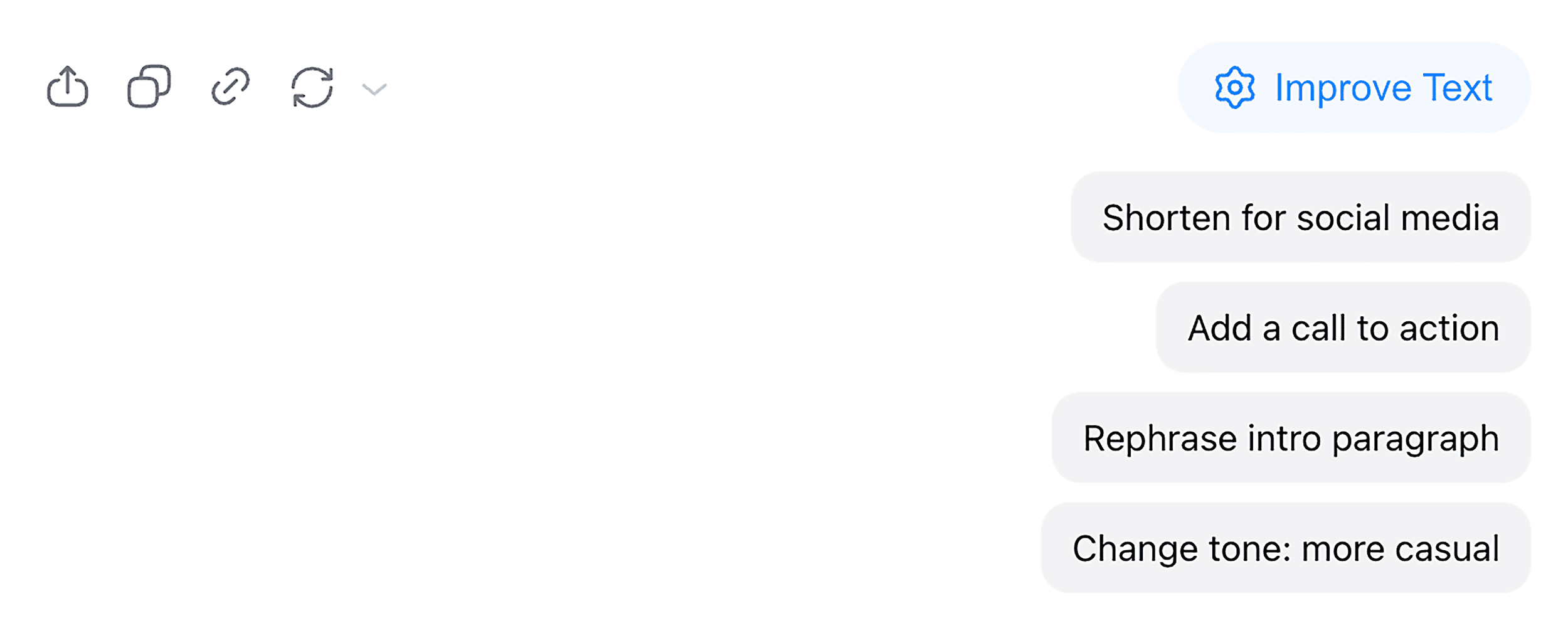
Further reading: How to Use AI for Writing Exceptional Content
Where Sigma Chat Falls Short
Sigma Chat’s presentation still needs work.
When I searched “best running shoes,” it opened with generic photos pulled from listicles.
This is a wasted use of prime real estate — they could’ve shown real products or reviews to provide more value.
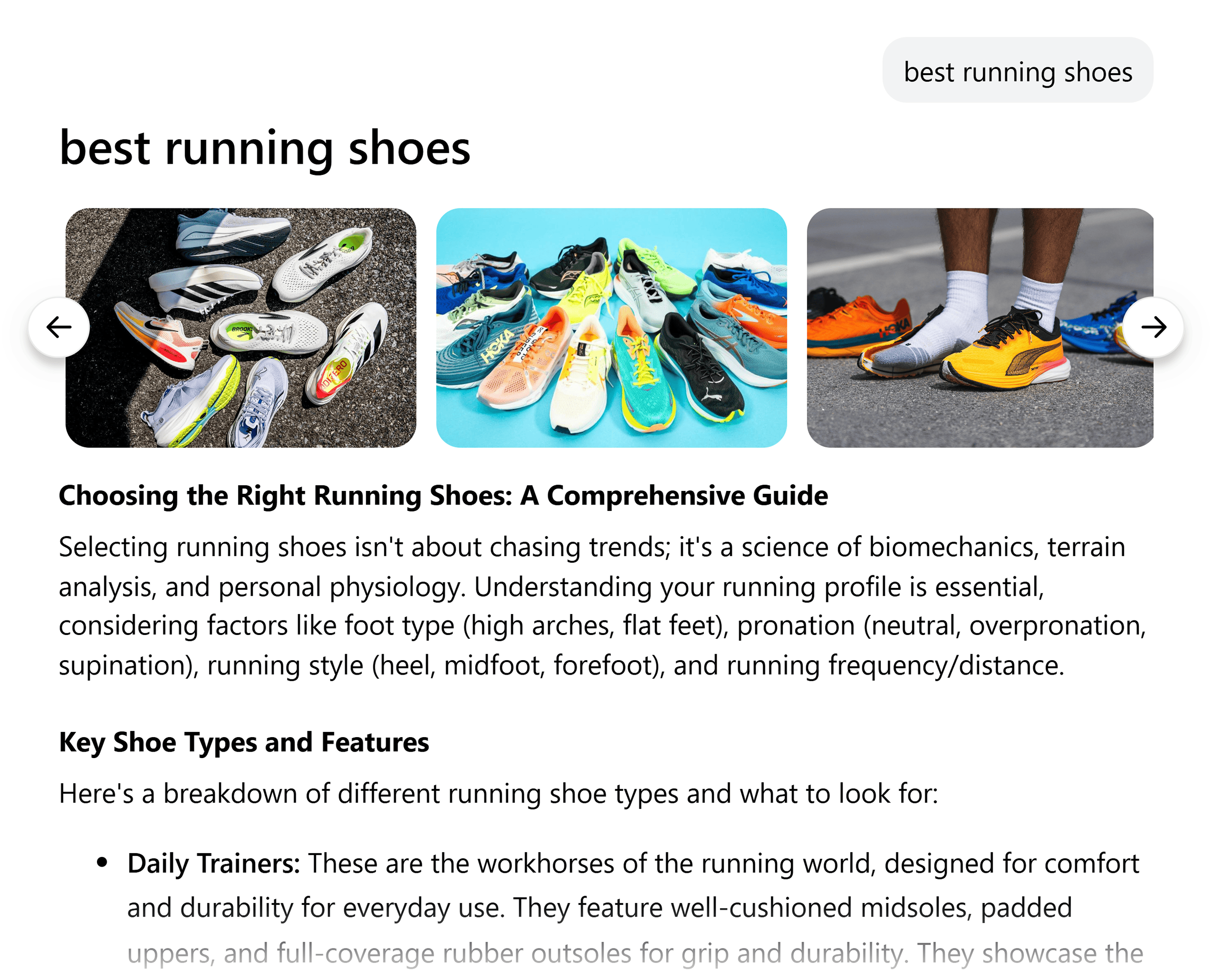
There are also no pricing details, reviews, or direct purchasing links.
But Sigma Chat does cite its sources.
In fact, it cited the same comparison article multiple times. (Helpful for that site’s traffic, not so helpful for someone ready to purchase.)
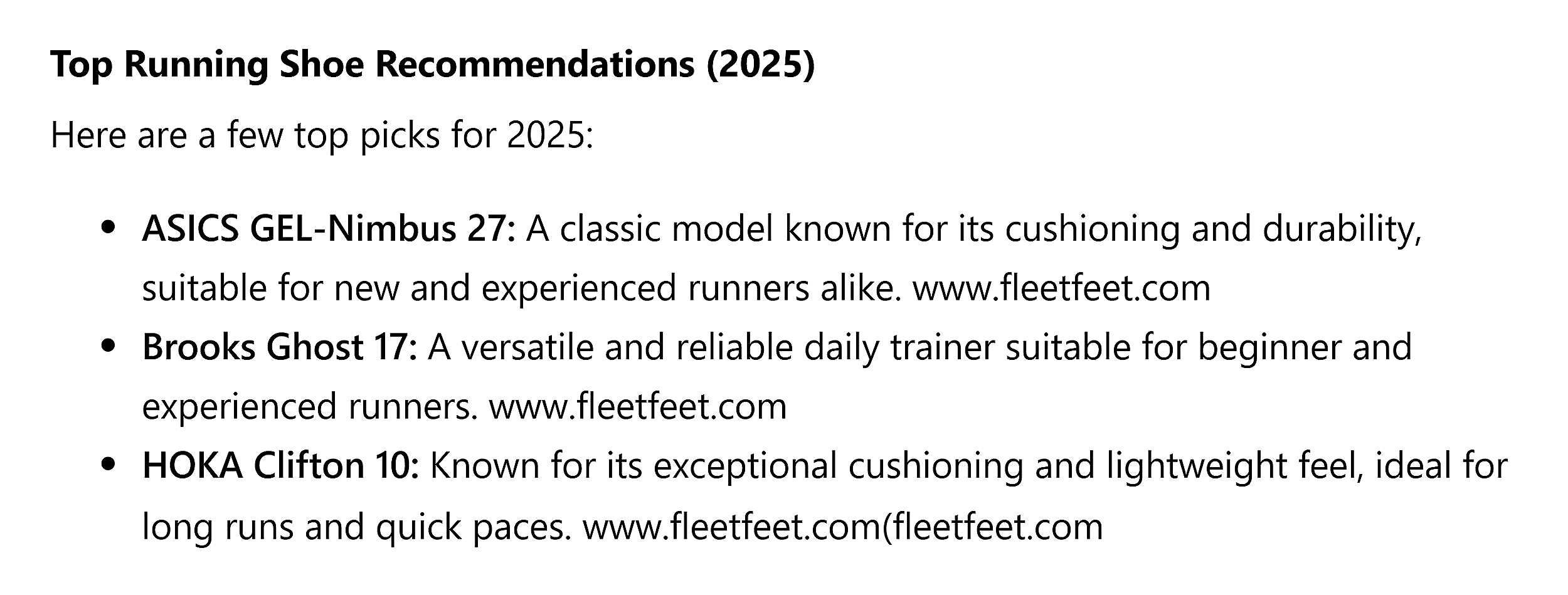
Unless Sigma Chat improves its commercial functionality, it’s unlikely shoppers will use it.
Instead, it might carve out a niche for itself as a deep research tool.
Pricing

Sigma Chat offers a few plans with varying access and features:
- Free: Basic search and chat capabilities
- SigmaChat Plus: $10/month for increased access
- SigmaChat Pro: $75/month for unlimited access
Further reading: 6 Awesome AI SEO Tools We Love Using
4. Microsoft Copilot
Best for fast answers in clean, skimmable formats
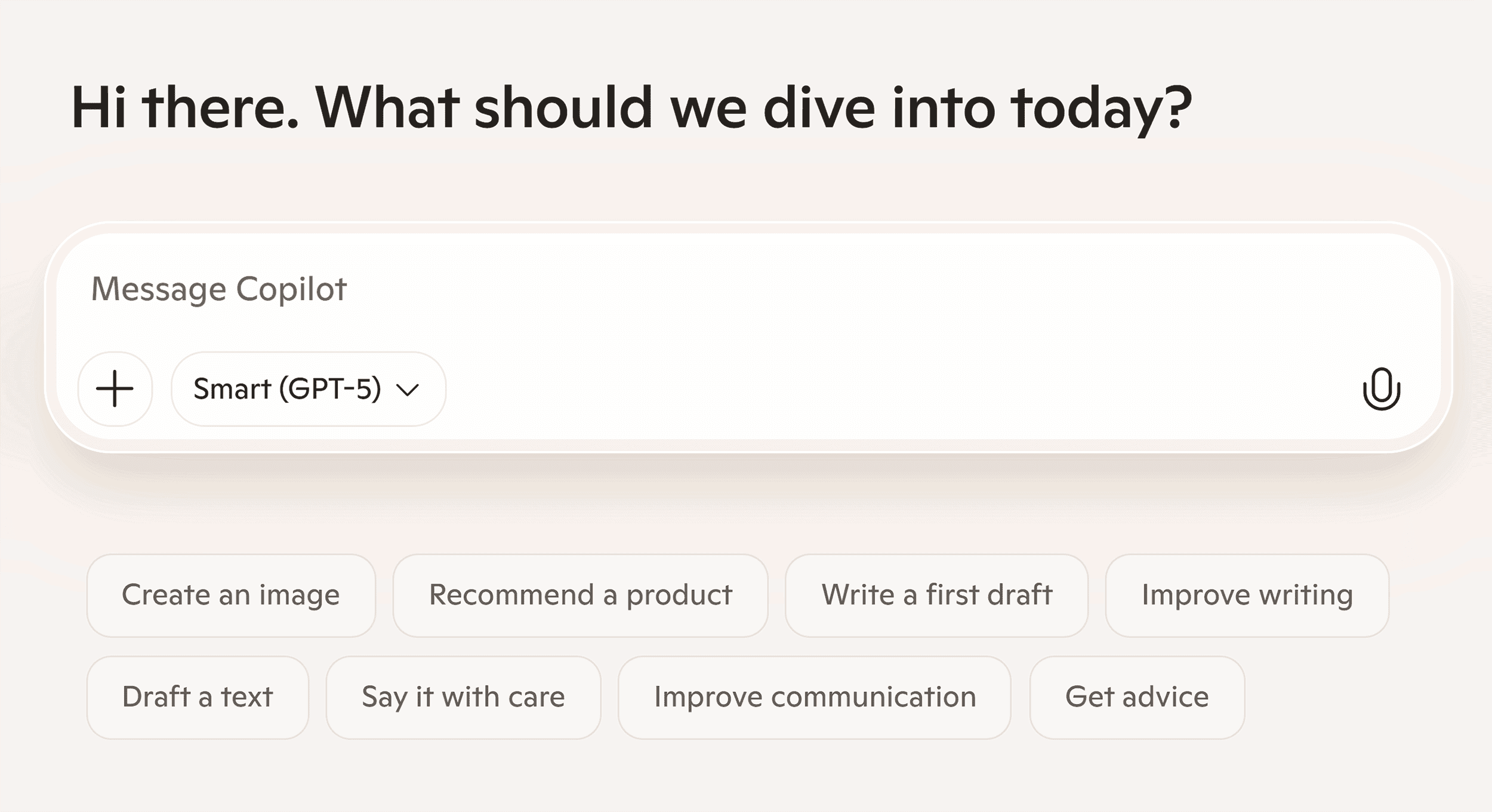
Microsoft Copilot has the cleanest layout of any AI search engine I tested.
It’s fast, structured, and organized. Perfect for people who want distraction-free takeaways.
What Microsoft Copilot Does Well
When you ask Copilot a question, it responds instantly with skimmable categories, bullet points, and emojis.
For example, when I searched “best running shoes,” it broke recommendations into helpful categories:
- “Best overall”
- “Best stability shoe”
- “Best daily trainer”
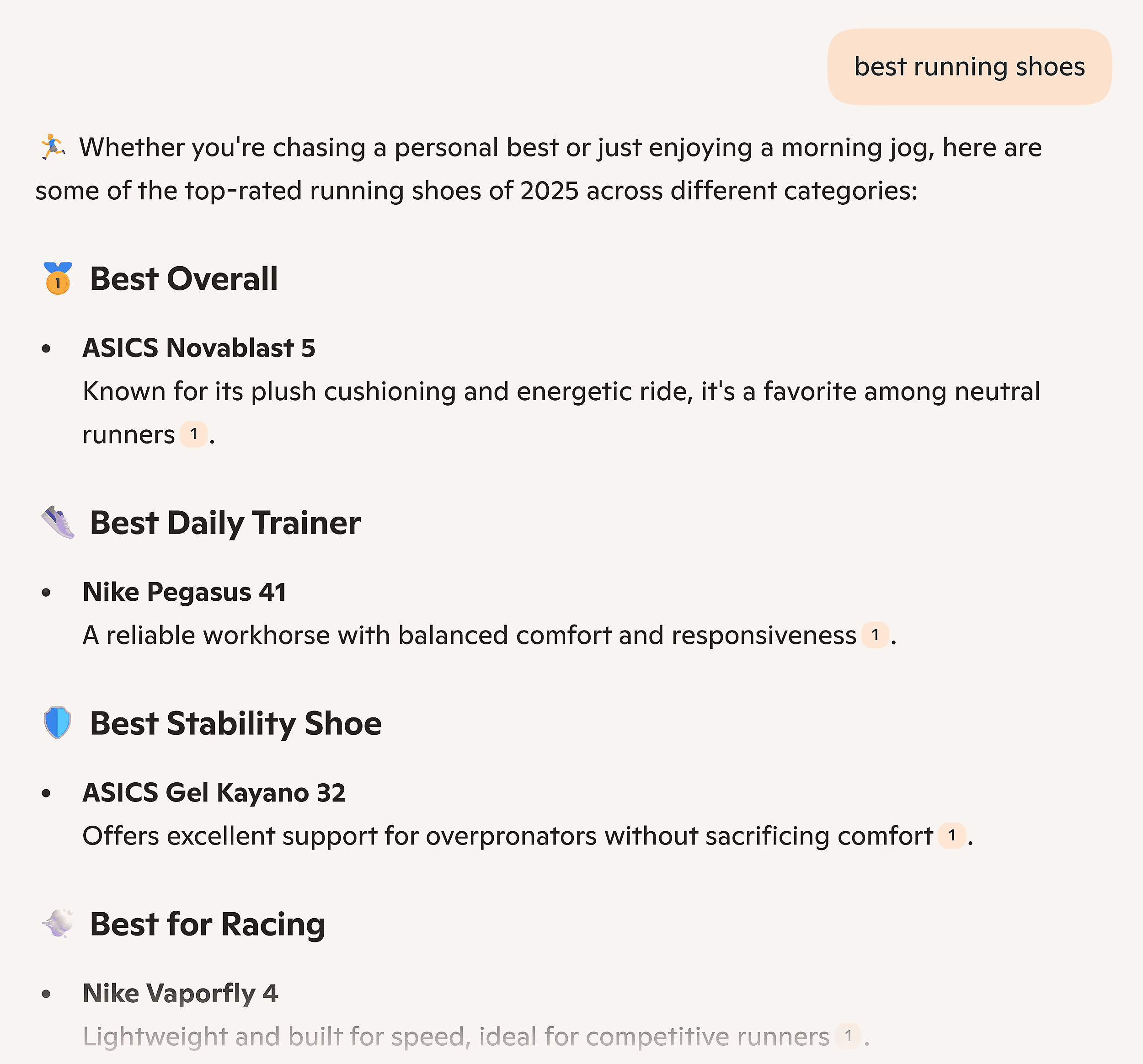
When I narrowed the query to “best running shoes for beginner marathon training,” Copilot further refined the results.
It added details about who each shoe was best for, making the advice more actionable — a nice touch for a tool focused on clarity.
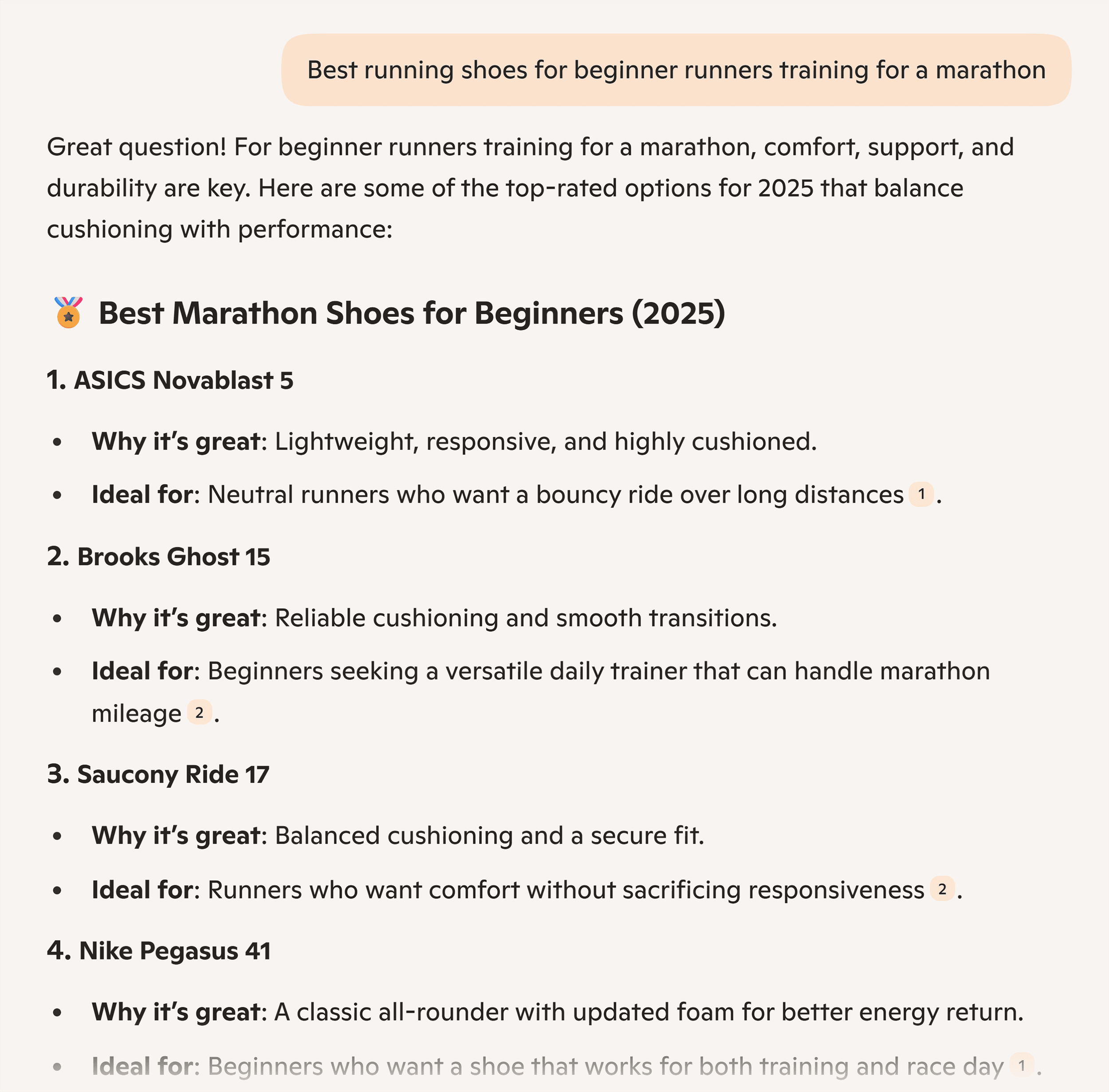
Even for informational queries like “can I wear these for hiking,” Copilot delivered a simple breakdown.
And added specific scenarios where running shoes would and wouldn’t be ideal for hiking.
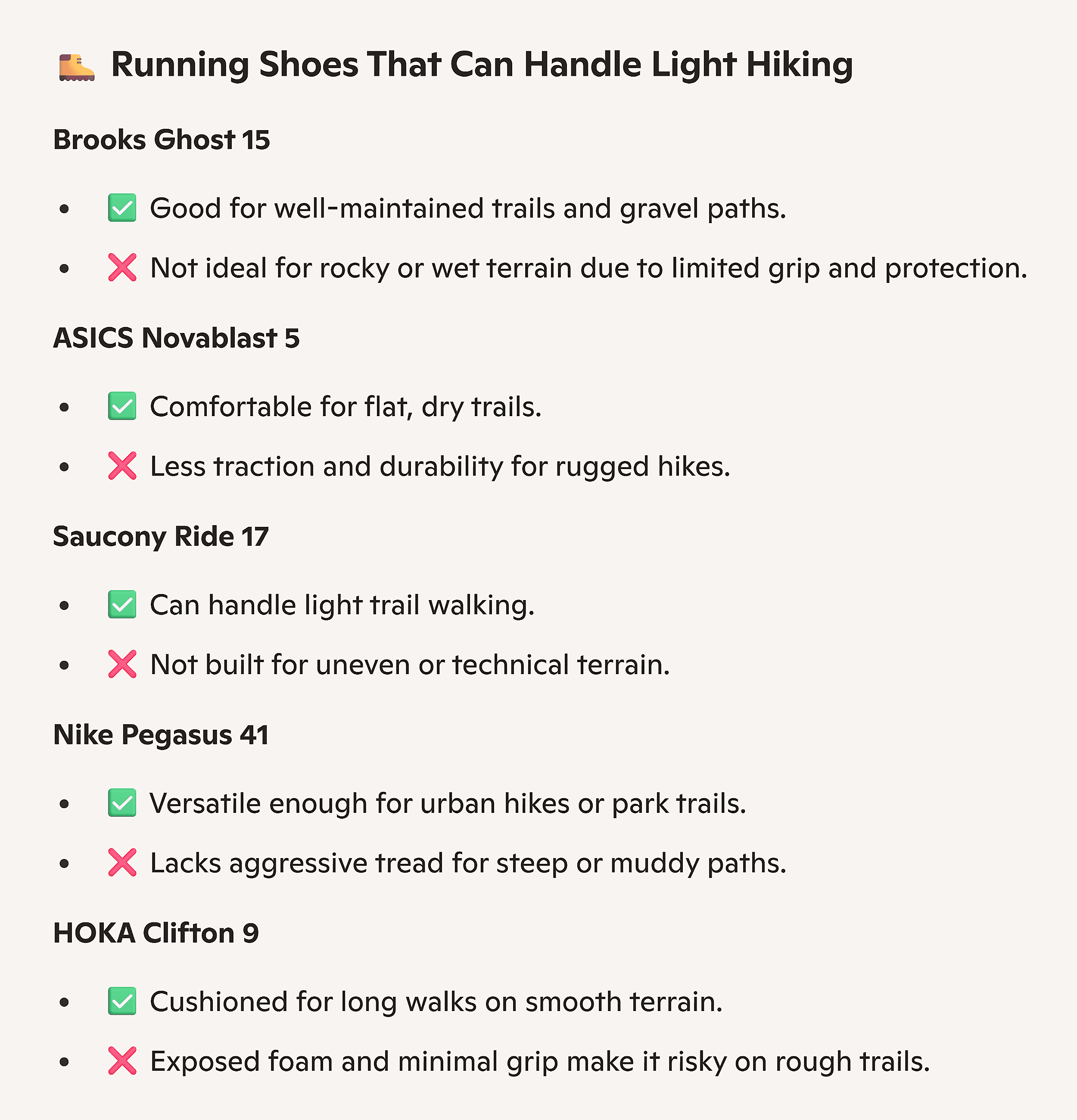
When you want fast, direct answers without having to sift through a bunch of content, Copilot is a great option.
For brands: Pay close attention to how Copilot structures its answers — categories, comparisons, “best for” labels. Use similar formatting on your own pages to help AI tools extract and present your content more effectively.
Where Microsoft Copilot Falls Short
Copilot’s polished format comes at a cost: depth and shoppability.
Its responses are tidy but often too surface-level — especially for commercial searches like “best running shoes.”
When I tested this prompt, it didn’t link directly to any product pages or show pricing.
So, I couldn’t easily comparison shop, verify information, or choose a merchant and purchase immediately.
Instead, it summarized content from other “best” listicles and linked those sources.
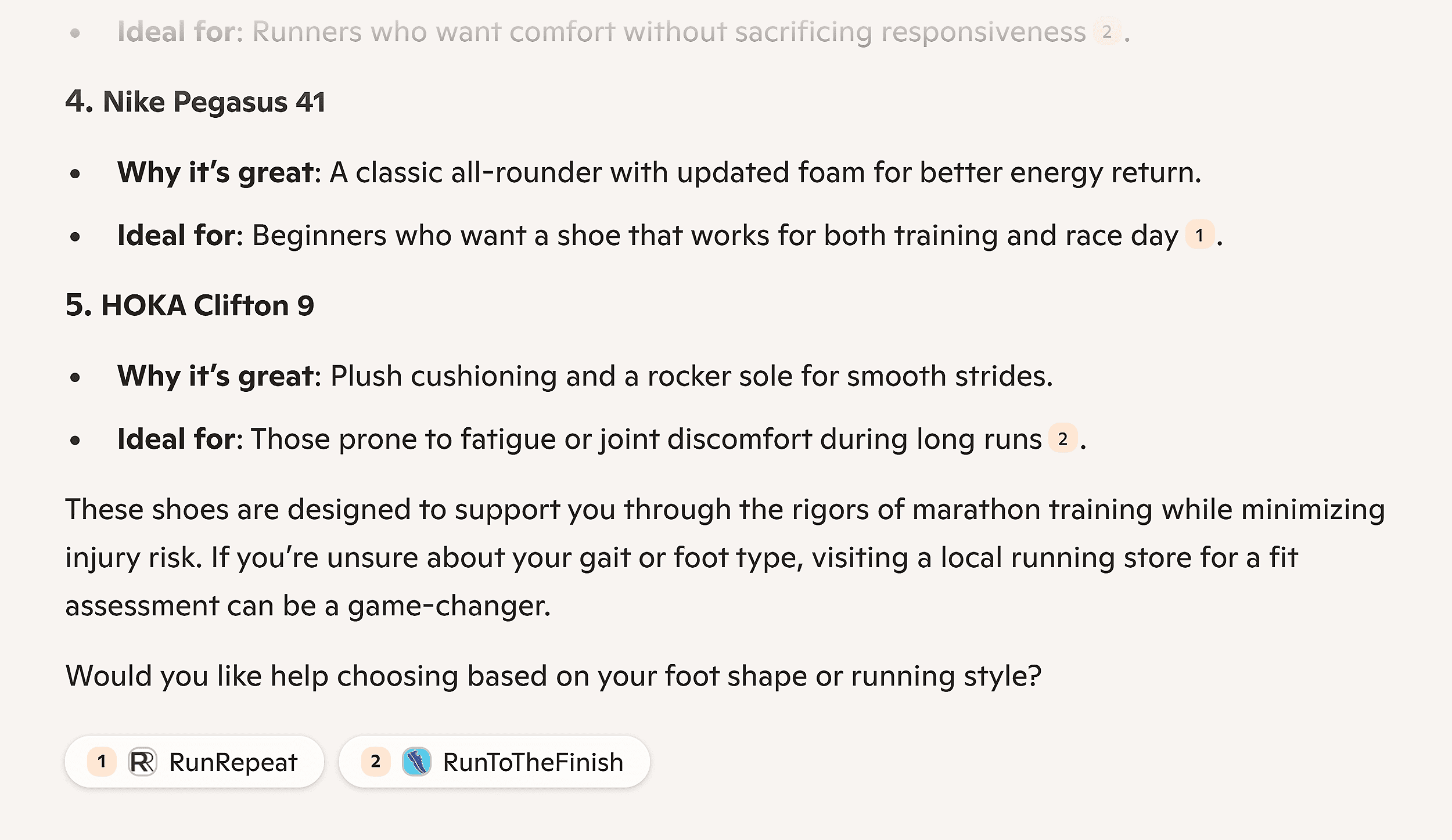
Like Sigma Chat, unless Microsoft improves its shoppability, it’s unlikely consumers will use it for this purpose.
Instead, Copilot works better as a light research tool — especially when you want fast information with minimal reading.
Pricing
Microsoft Copilot is free to use.
Further reading: 5 LLM Visibility Tools to Track Your Brand in Search
AI Search Engines That Didn’t Make the Cut (and Why)
All of these AI search engines had their pros and cons.
But overall, they fell short for different reasons.
Claude
I really liked Claude, but the output was very similar to ChatGPT.
This isn’t a problem, but I didn’t want to list tools that were similar in functionality.
I wanted to provide only the best.
Compared to ChatGPT, Claude lacked product links and visuals:
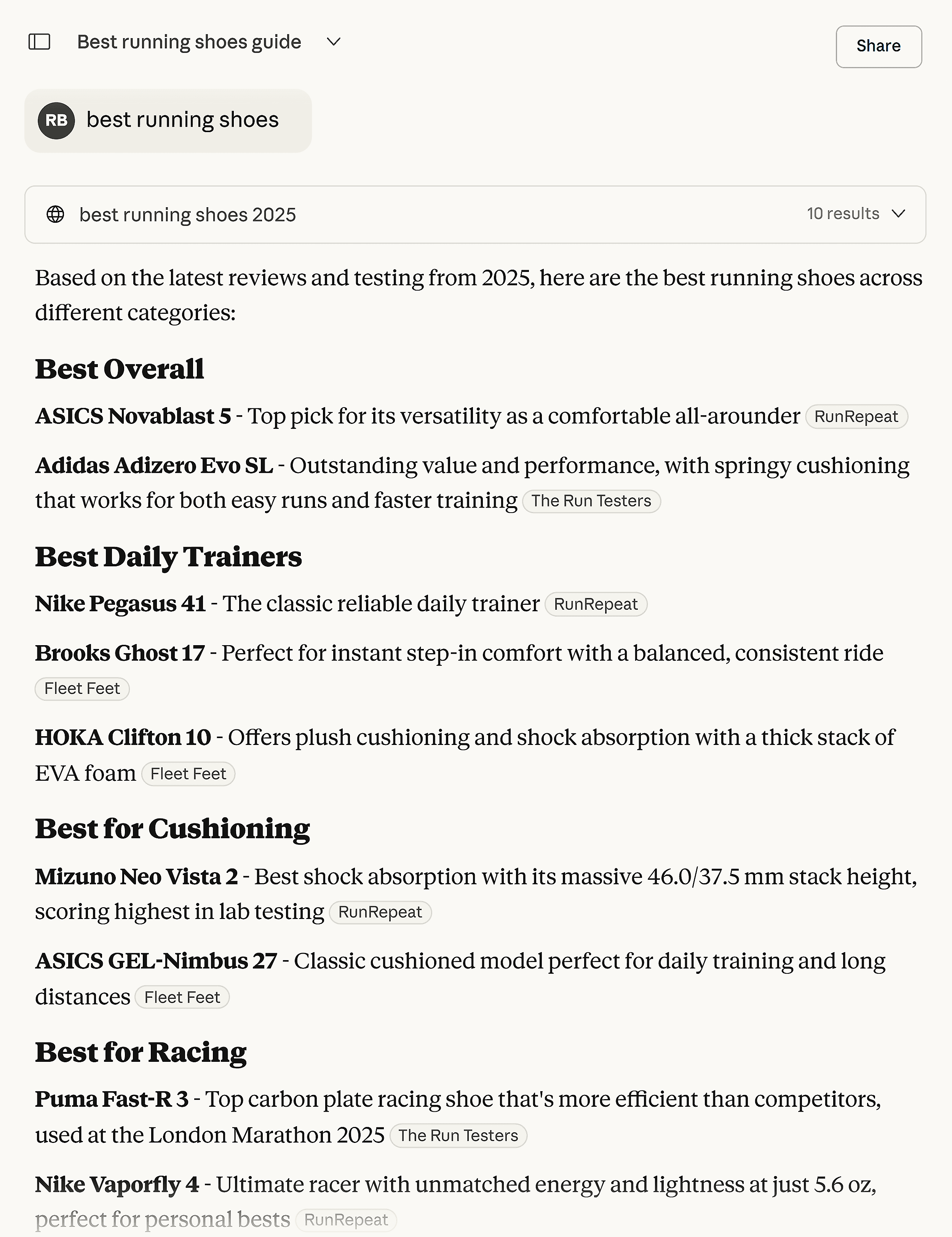
The wall of text made the information challenging to process.
I did like the categorization, but ChatGPT does this too — with tables that are easier to skim.
Perplexity
Like Claude, Perplexity came somewhat close to ChatGPT in overall performance.
When asked a prompt with buying intent, it provided a short summary along with product images, pricing, and star ratings.
No tables to help me quickly compare features and options, though.

The summary was also fairly generic.
And didn’t feel all that tailored to my prompt, even when I used the more specific “marathon” wording.
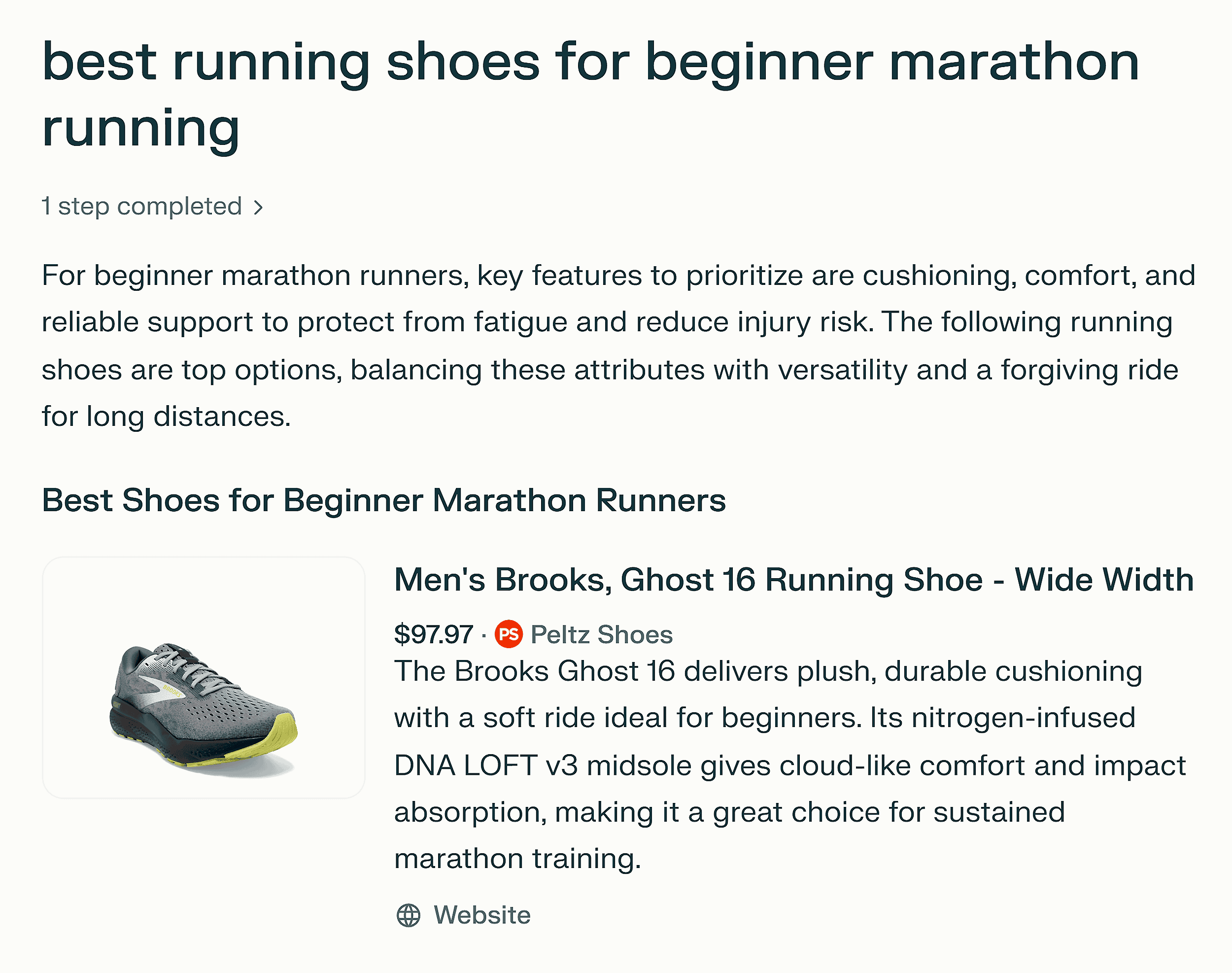
Brave
Brave, a privacy-focused AI search engine, felt too much like traditional search.
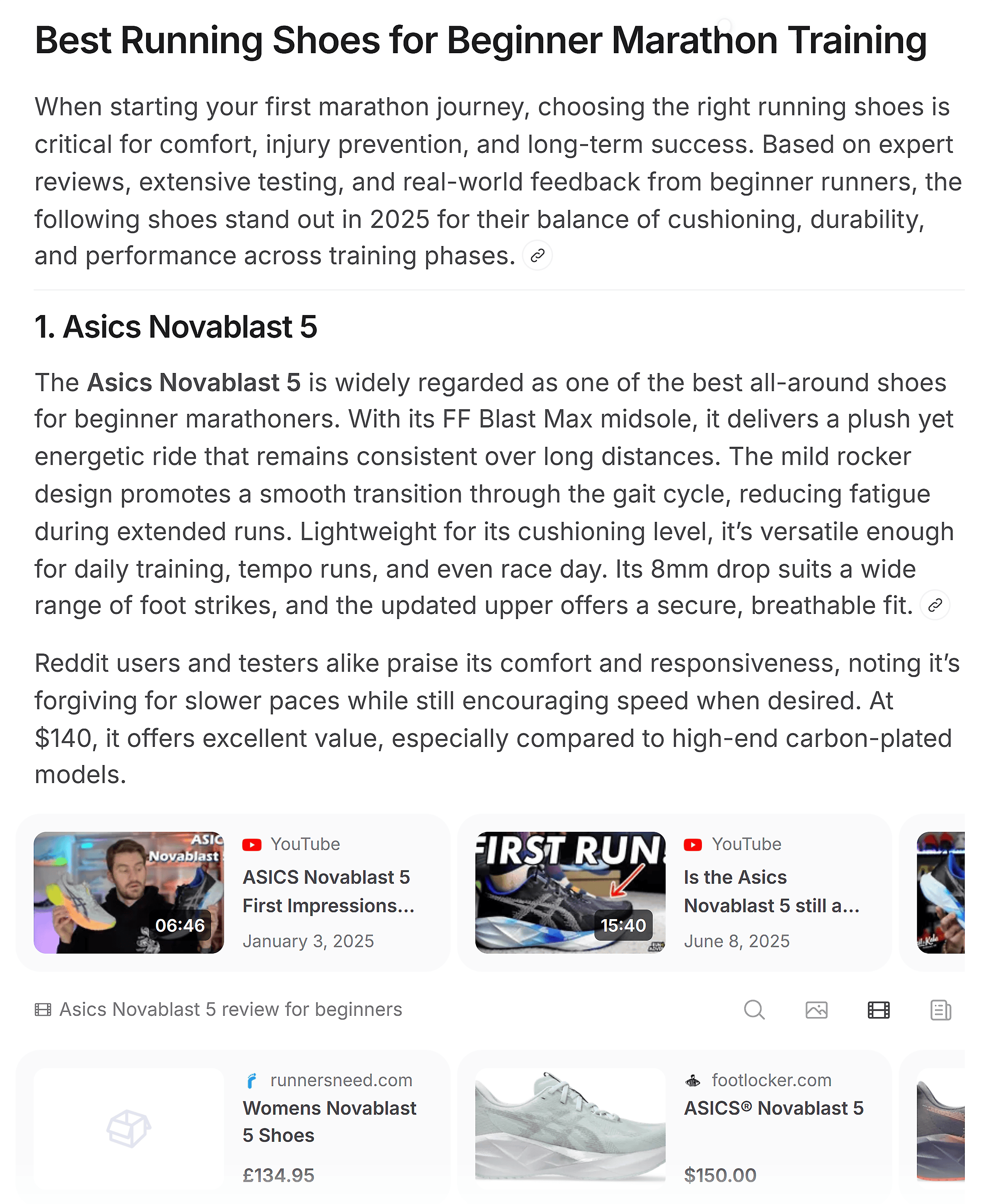
It features long lists of articles without any clear hierarchy or comparison features.
While this might be helpful for browsing links, it doesn’t summarize much or help you make quick decisions.
Andi
Andi, a minimal AI search tool, offered few results, sometimes just one (e.g., a single Reddit thread).
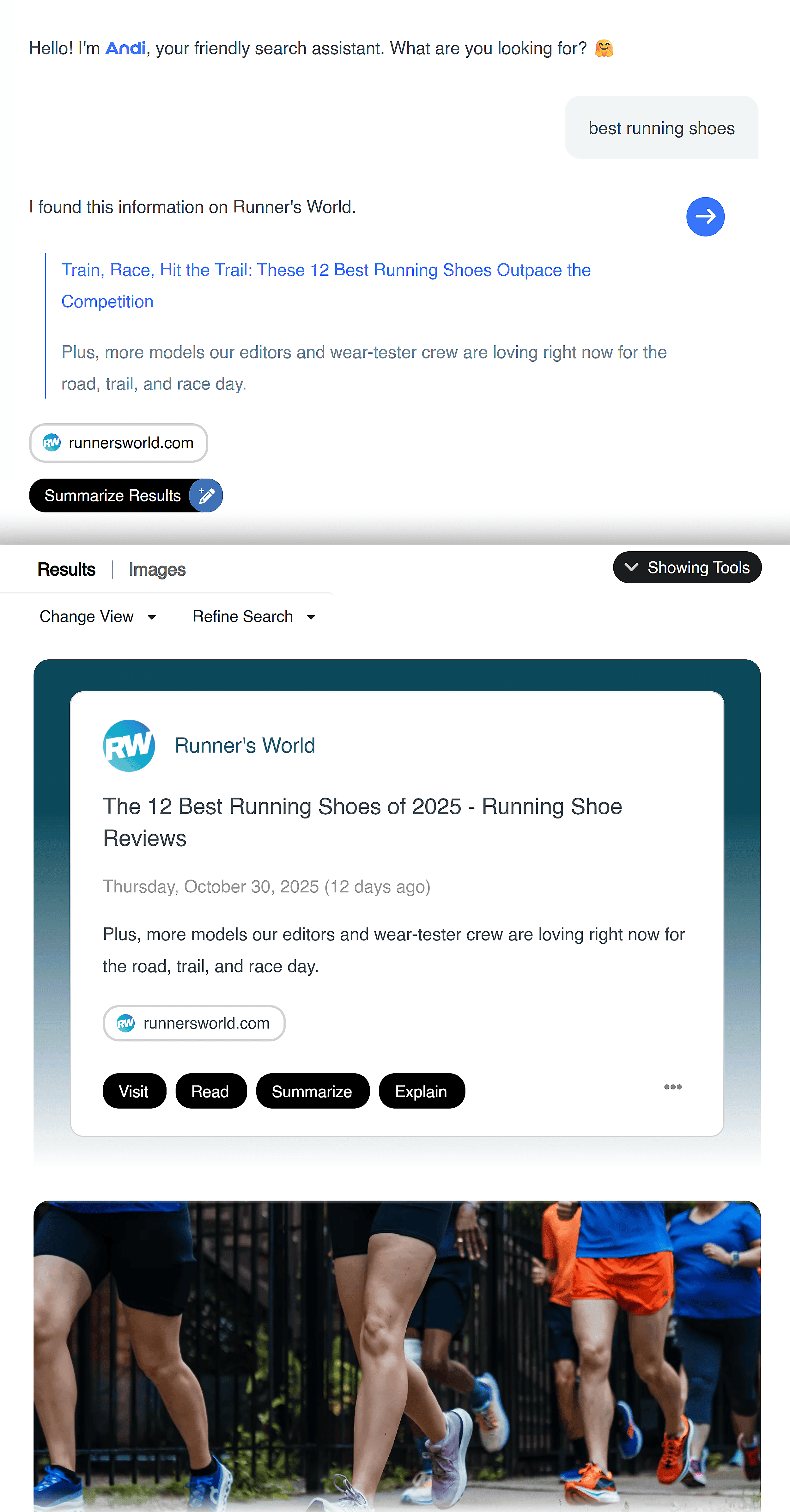
It’s a bit like the “I’m Feeling Lucky” button on Google. Simple to use but extremely limiting for in-depth research or shopping.
Arc
Arc, a mobile- and browser-based AI search engine, requires a download to use.
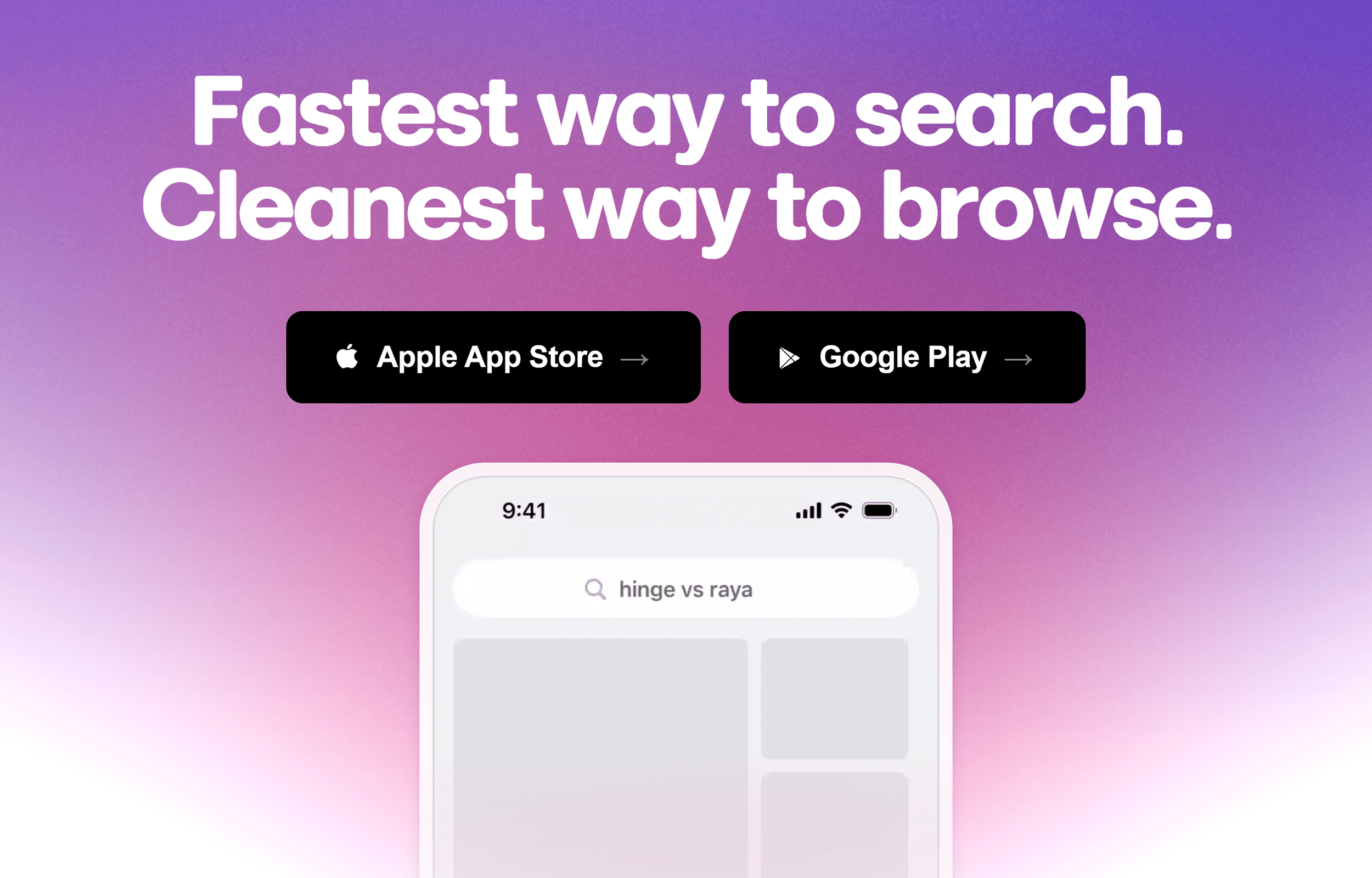
This is inconvenient compared to browser-based AI search.
When so many other options exist, it’s hard to justify using this AI engine for this reason alone.
You
You is a solid AI search engine that has been around for multiple years.
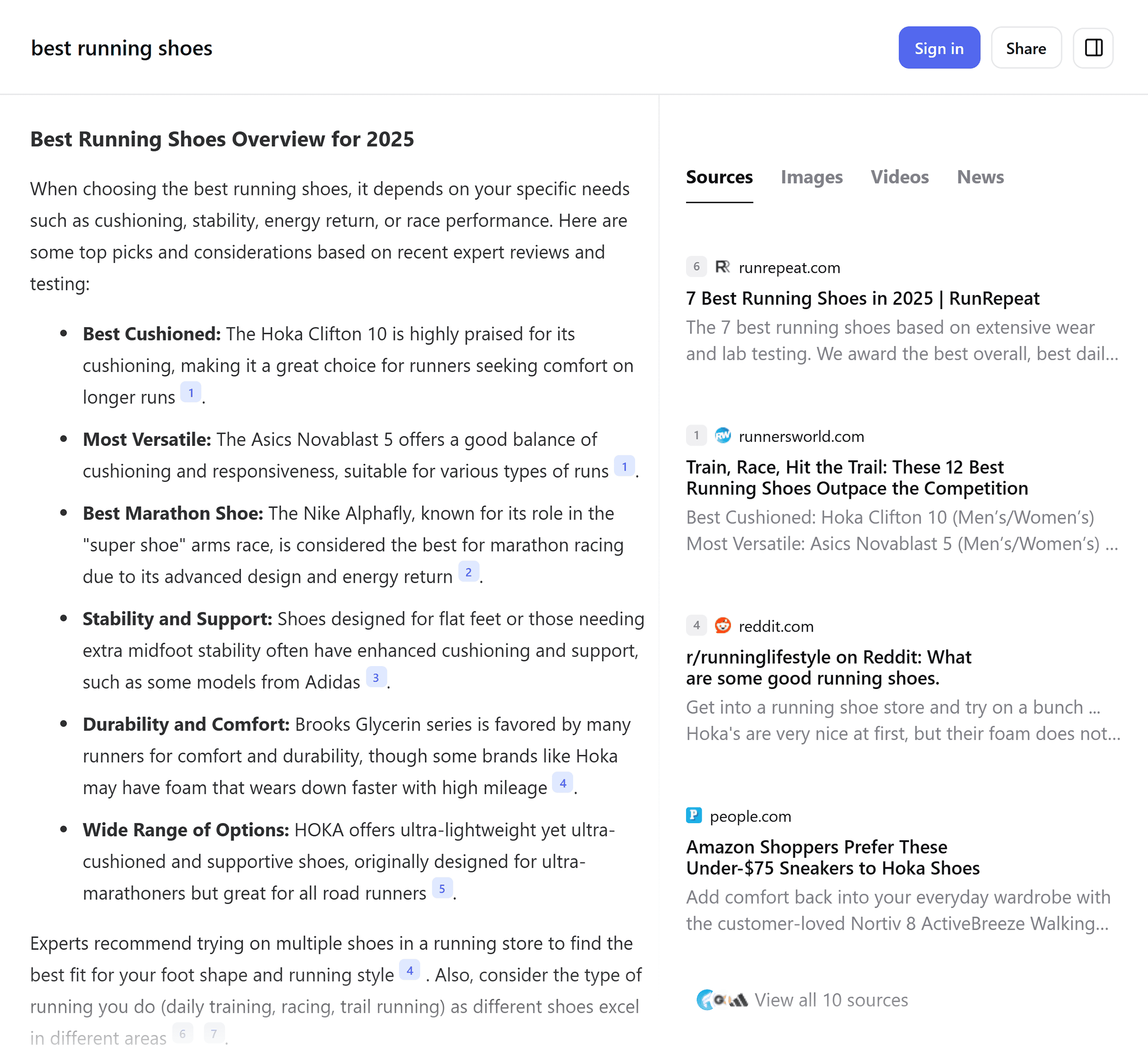
But it was slow to respond and didn’t link to products in commercial searches.
Ultimately, I found it less useful than the other AI tools overall.
What This Means for Your AI Search Visibility
After testing 11 AI search engines, one thing became clear.
No matter how their formatting or preferences differ, the goal remains the same: to serve clear, credible, and well-structured content.
If your pages do that — with comprehensive coverage, positive reviews, and clean markup — you’ll be positioned to perform well across all AI search engines and LLMs.
Want to make that happen?
Our generative engine optimization (GEO) guide shows how to structure your site, earn more citations, and track your AI visibility.
Backlinko is owned by Semrush. We’re still obsessed with bringing you world-class SEO insights, backed by hands-on experience. Unless otherwise noted, this content was written by either an employee or paid contractor of Semrush Inc.




